- Ex.2.1
- Ex.2.2
- Ex.2.3
- Ex.2.4
- Polynomials Class 10 Extra Questions
- Polynomials Class 10 Important Questions
- Polynomials Class 10 Notes
NCERT Solutions for Class 10 Maths Chapter 2 Polynomials Ex 2.1
Ex 2.1 Class 10 Maths Question 1:
The graphs of y = p(x) are given below for some polynomials p(x). Find the number of zeroes of p(x) in each case.
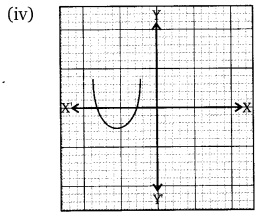
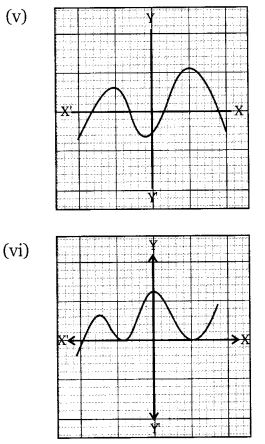
Solution: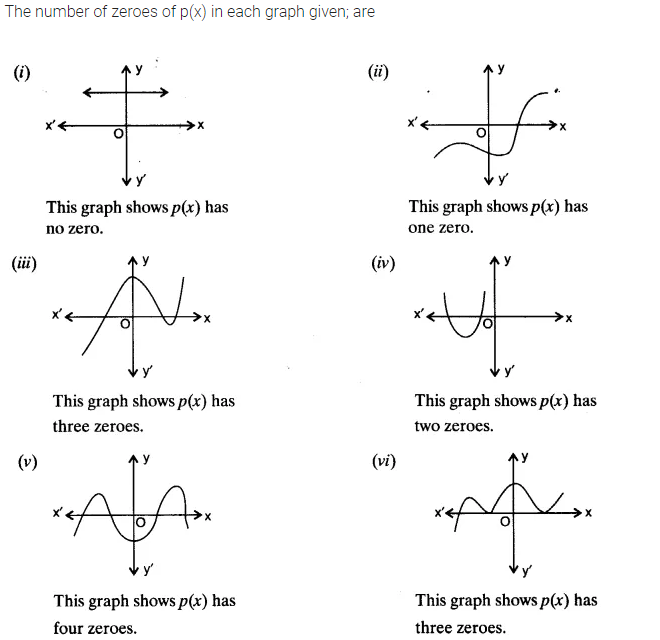
You can also download the free PDF of Ex 2.1 Class 10 Polynomials NCERT Solutions or save the solution images and take the print out to keep it handy for your exam preparation.
NCERT Solutions for Class 10 Maths Chapter 2 Polynomial (Hindi Medium) Ex 2.1
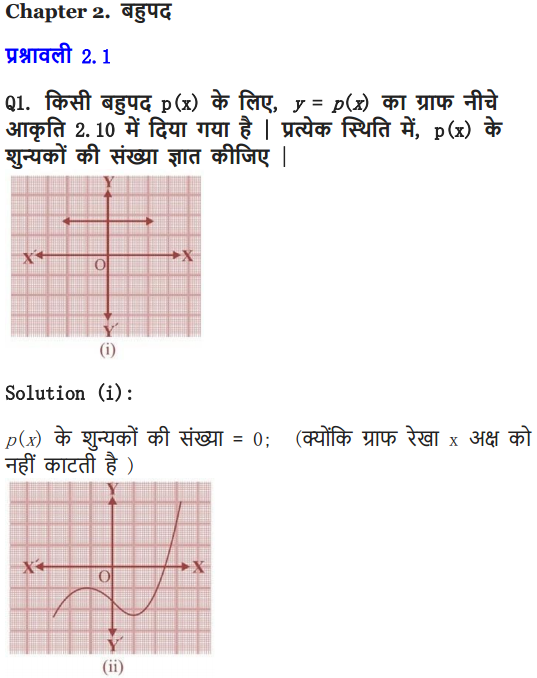
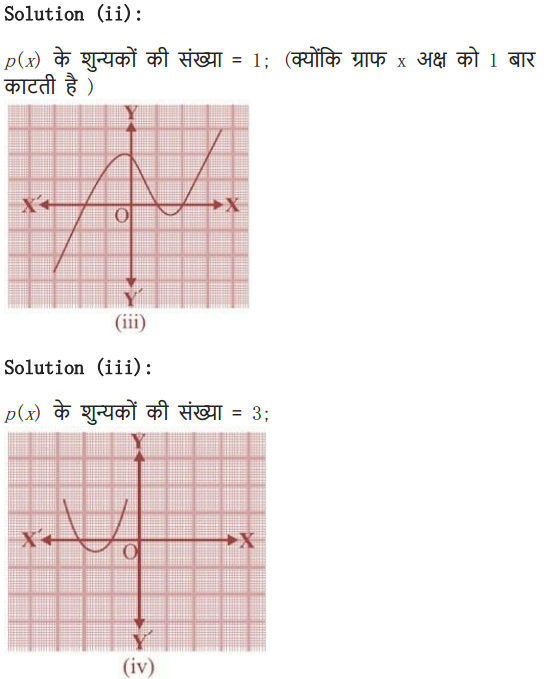
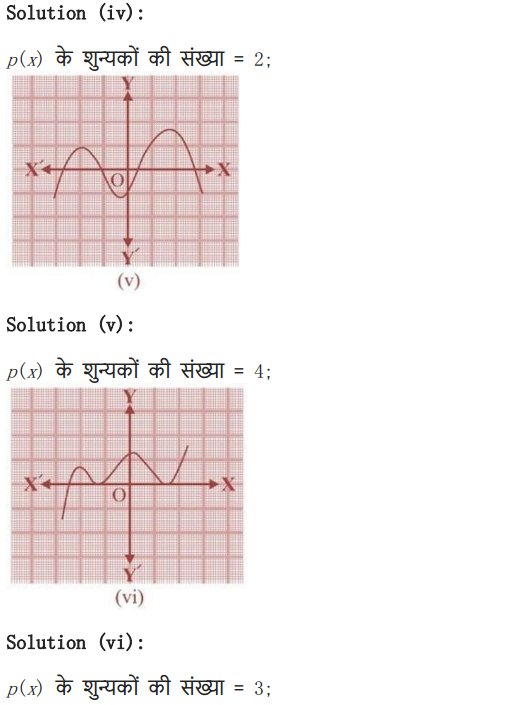
Class 10 Maths Chapter 2 Ex 2.2 NCERT Solutions
Ex 2.2 Class 10 Maths Question 1.
Find the zeroes of the following quadratic polynomials and verify the relationship between the zeroes and their coefficients:
(i) x2 – 2x – 8
(ii) 4s2 – 4s + 1
(iii) 6x2 – 3 – 7x
(iv) 4u2 + 8u
(v) t2 – 15
(vi) 3x2 – x – 4
Solution: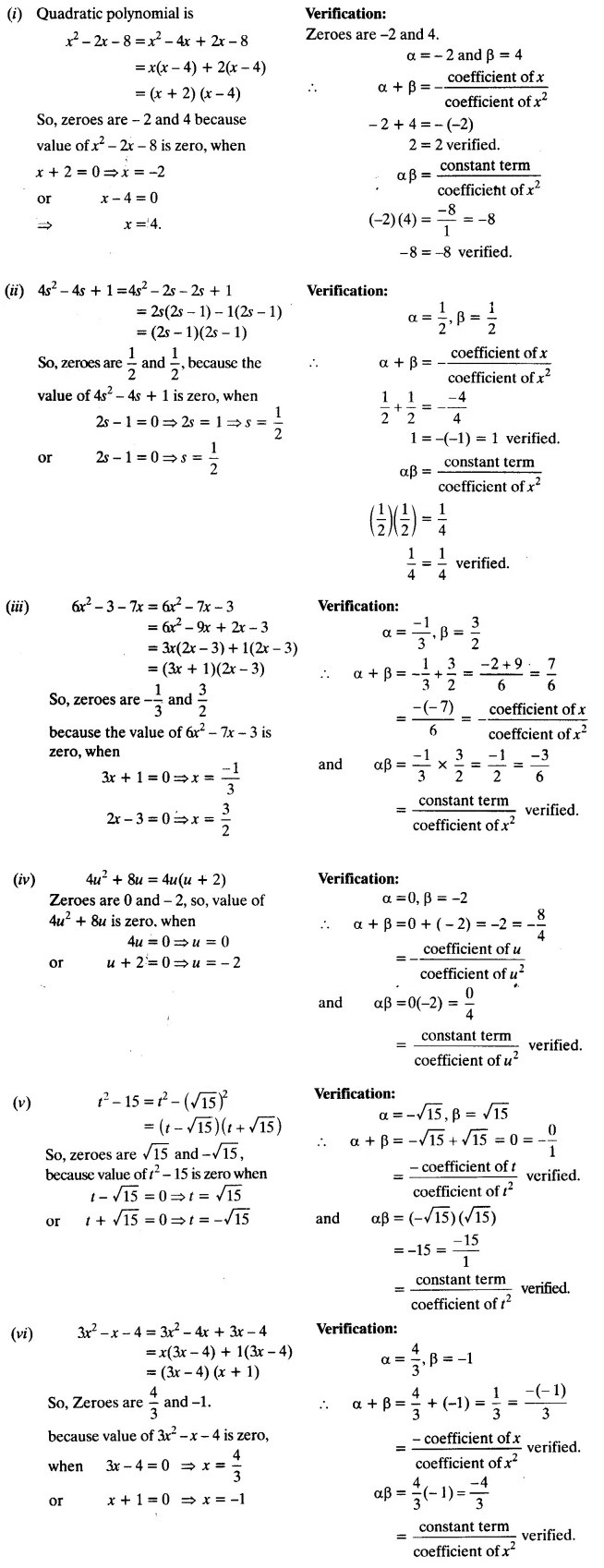
Ex 2.2 Class 10 Maths Question 2.
Find a quadratic polynomial each with the given numbers as the sum and product of zeroes respectively:
Solution: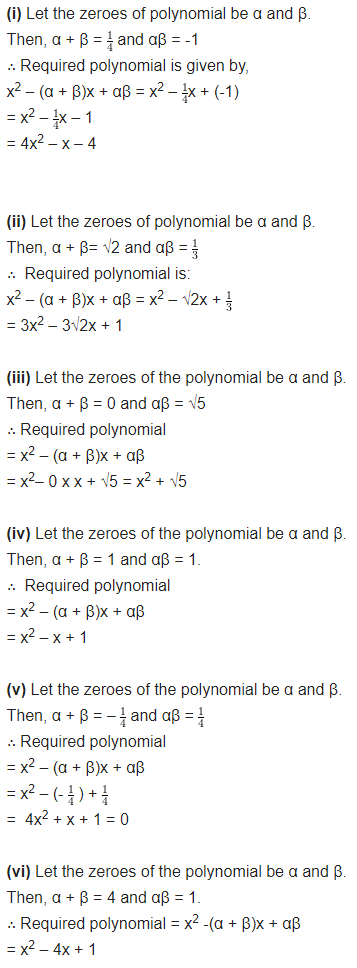
NCERT Solutions for Class 10 Maths Chapter 2 Polynomial (Hindi Medium) Ex 2.2
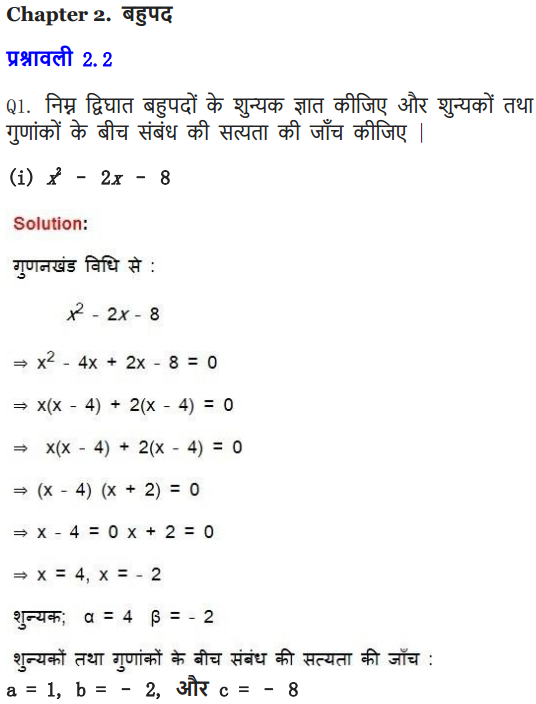
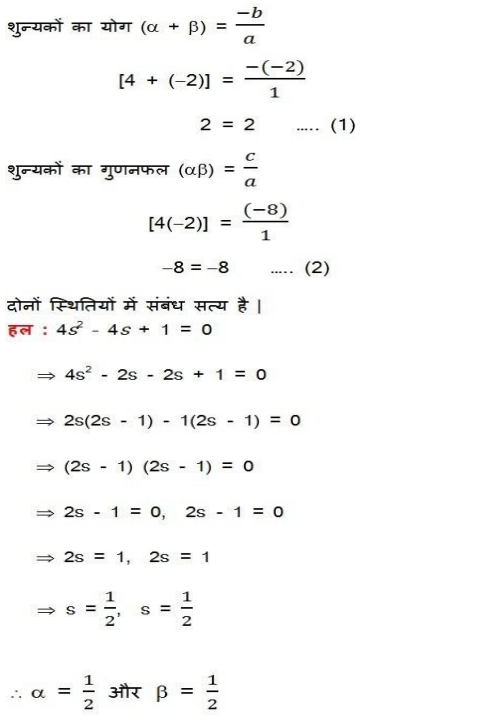
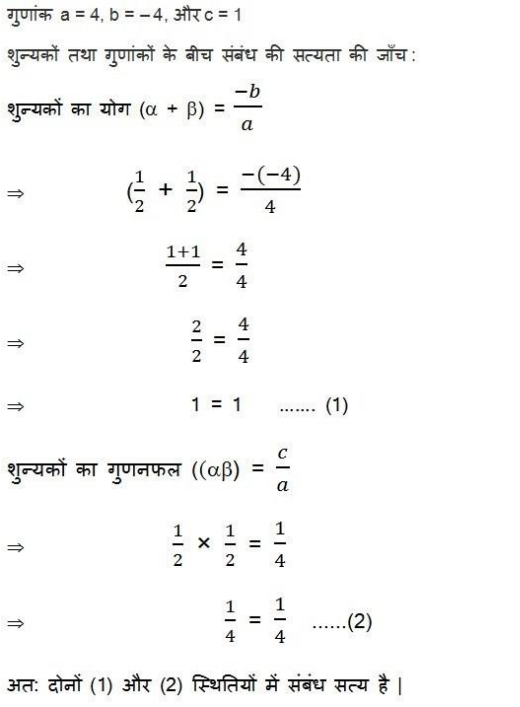
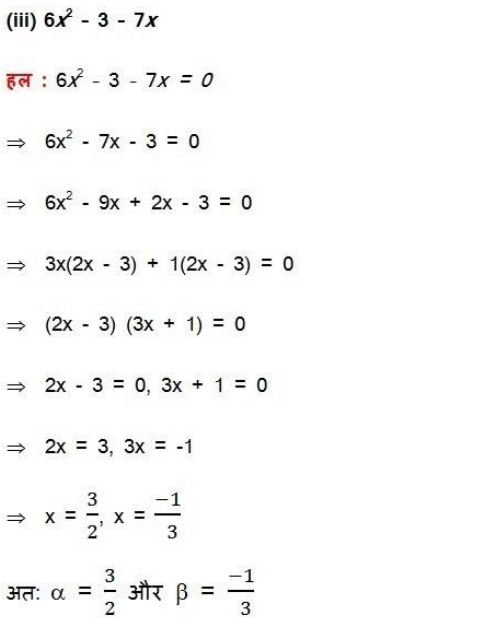
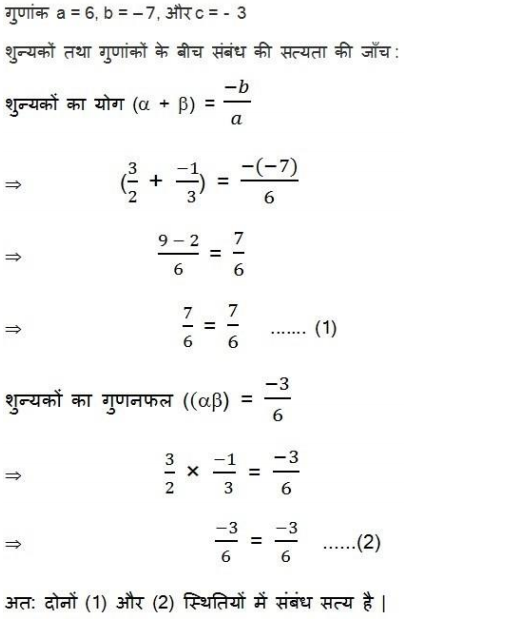
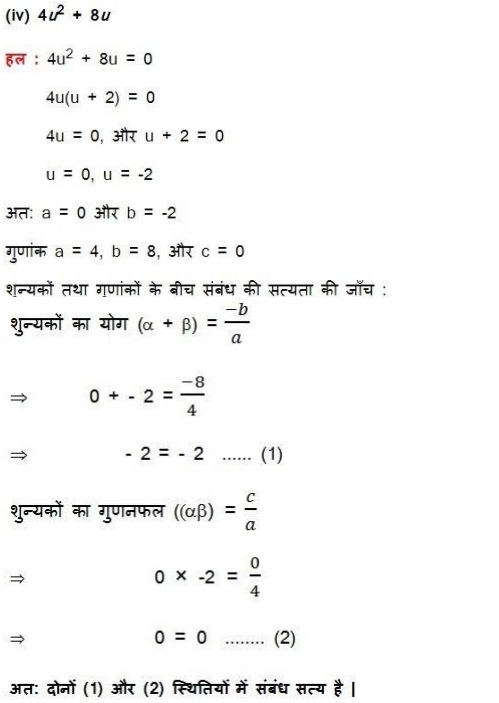
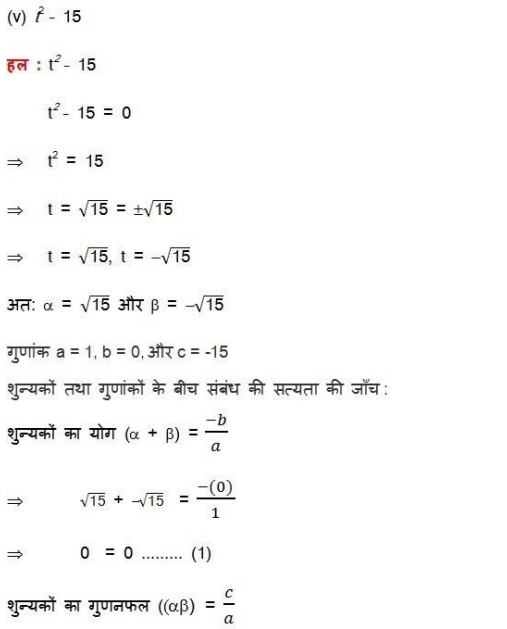
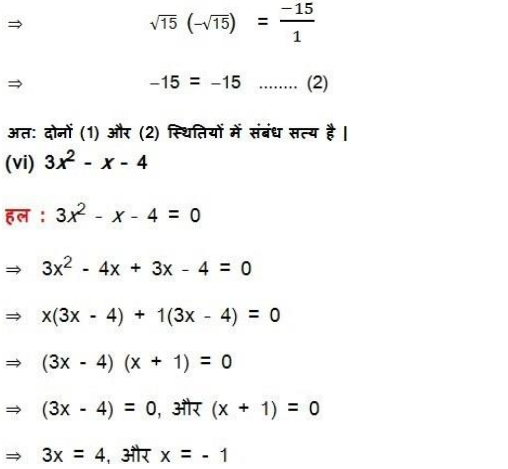
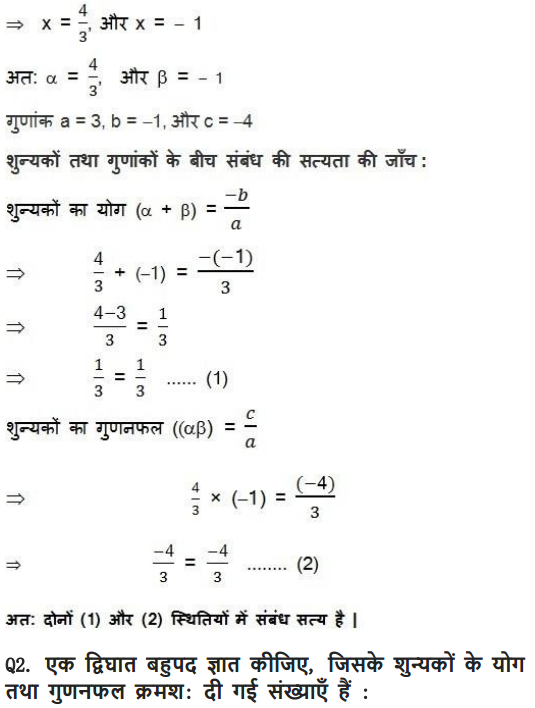
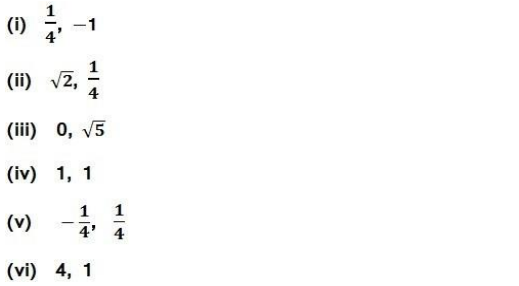
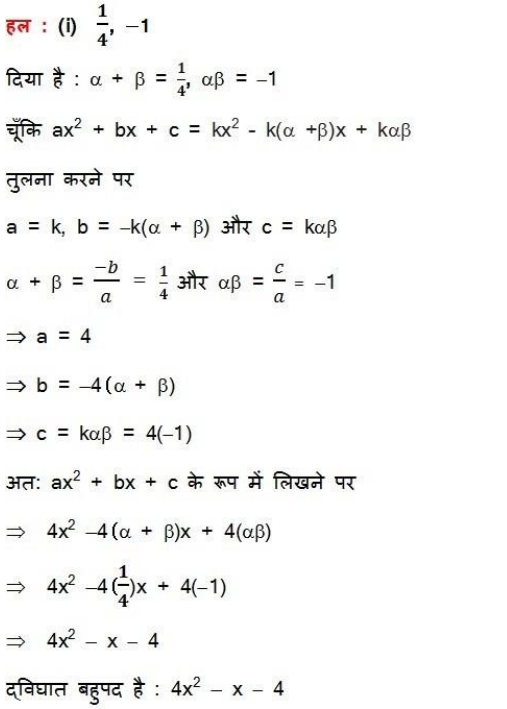
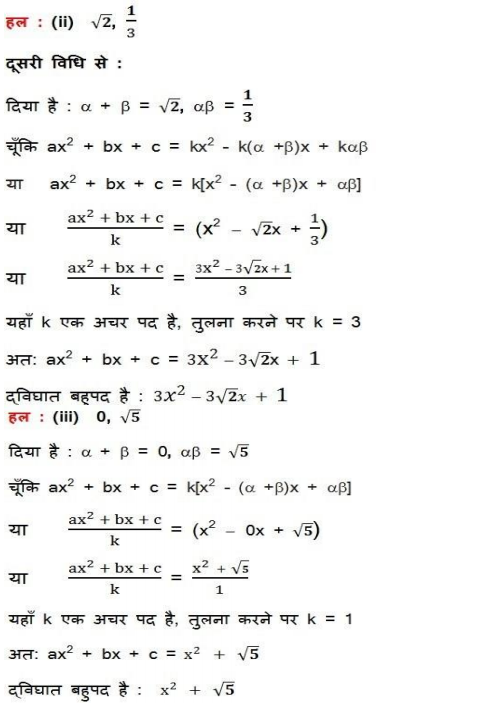
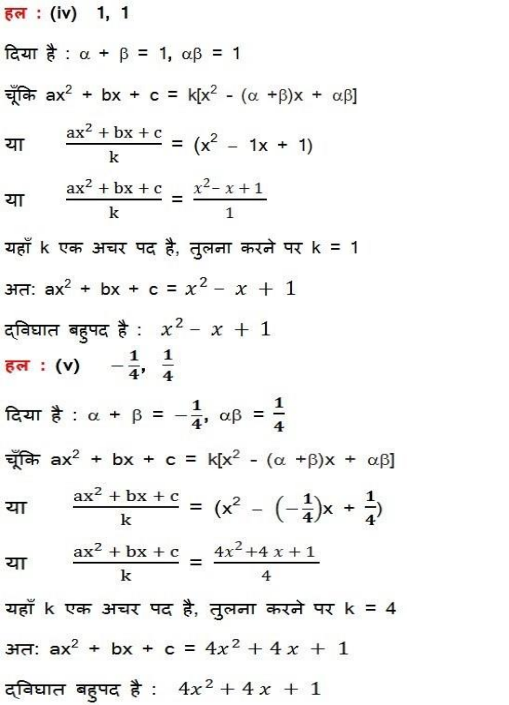
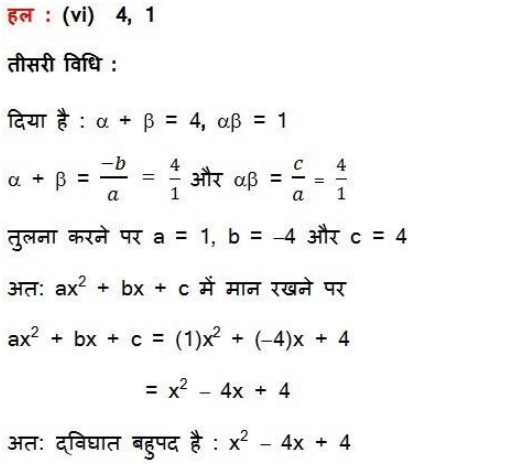
Polynomials Class 10 Extra Questions Very Short Answer Type
Question 1.
The graph of a quadratic polynomial x2 – 3x – 4 is a parabola. Determine the opening of parabola.
Answer:
∵ In x2 – 3x – 4, the Coefficient of x2 is 1 and 1 > 0.
∴ The parabola opens upwards.
Question 2.
If p(x) = x2 + 5x + 2, then find p(3) + p(2) + p(0).
Answer:
p(3) = 32 + 5(3)+ 2 = 26
p(2) = 22 + 5(2) + 2 = 16
p(0) = 02 + 5(0) + 2 = 2
⇒ p(3) + p(2) + p(0) = 26 + 16 + 2 = 44
Question 3.
The graph of y = p(x) is shown in the figure below. How many zeroes does p(x) have?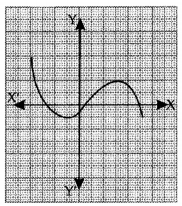
Answer:
Since, the curve (graph) of p(x) is intersecting the x-axis at three points, y = p(x) has 3 zeroes.
Question 4.
The coefficient of x and the constant term in a linear polynomial are 5 and – 3 respectively, find its zero.
Answer:
∵ The zero of a linear polynomial = –
∴ The zero of the given linear polynomial
= –
Question 5.
What is the value of p(x) = x2 – 3x – 4 at x = -1 ?
Answer:
We have: p(x) = x2 – 3x – 4
∴ P(- 1) = (- 1)2 – {3(- 1)} – 4 = 1 + 3 – 4
= 0
Question 6.
If the polynomial p(x) is divisible by (x – 4) and 2 is a zero of p(x), then write the corresponding polynomial.
Answer:
Here, p(x) is divisible by (x – 4) and also 2 is a zero of p(x), therefore p(x) is divisible by (x – 4) and (x – 2)
Thus, the required polynomial p(x) = (x – 4) (x – 2) = x2 – 6x + 8.
Question 7.
If (α – β), α, (α + β) are zeroes of the polynomial p(x) = 2x3 – 16x2 + 15x – 2, then find the value of α
Answer:
Sum of zeroes = –
⇒ (α – β), α, (α + β) =
⇒ 3α = 8
⇒ α =
Question 8.
What is the zero of 2x + 3?
Answer:
∵ The zero of a linear polynomial = –
∴ The zero of 2x + 3 = –
Question 9.
Find the value of p for which the poloynomial x3 + 4×2 – px + 8 is exactly divisible by (x – 2).
Here p(x) = x3 + 4x2 – px + 8
∵ (x – 2) divides p(x), exactly
⇒ P(2) = 0
⇒ (2)3 + 4 (2)2 – p(2) + 8 = 0
2p = 32 ⇒ p = 16
Question 10.
If α and β are zereos of the polynomial 2x2 – 5x + 7, then find the value of α-1 + β-1.
Answer:
Here p(x) = 2x2 – 5x + 7
α, β are zeroes of p(x)
Question 11.
If p and q are the roots of ax2 – bx + c = 0, a ≠ 0, then find the value of p + q.
Answer:
Here, p and q are the roots of ax2 – bx + c = 0.
Sum of roots =
∴ p + q =
Question 12.
If – 1 is a zero of quadratic polynomial, p(x) = kx2 – 5x – 4, then find the value of k.
Answer:
Here p(x) = kx2 – 5x – 4
Since – 1 is a zero of p(x)
∴ P(- 1) = o
⇒ k (-1)2 – 5(- 1) – 4 = 0
⇒ k + 5 – 4 = 0
⇒ k = – 1
Polynomials Class 10 Extra Questions Short Answer Type-1
Question 1.
Find the quadratic polynomial whose sum of zeroes is 8 and their product is 12. Hence find zeroes of polynomial.
Answer:
Let, α, β be zereos of polynomial.
Now, here α + β = 8, αβ = 12.
Required polynomial
p(x) = k{x2 – (α + β) x + α β),
k is a constant.
⇒ p(x) = k{x2 – 8x + 12}
In particular, taking k = 1
Reqd. polynomial = x2 – 8x + 12
Now, p(x) = x2 – 8x + 12
= x2 – 6x – 2x + 12
= x(x – 6) – 2(x – 6)
= (x – 6) (x – 2)
∴ p(x) = o
⇒ x = 6, 2
Thus zeroes of polynomial are 6 and 2.
Question 2.
Check whether x2 + 3x + 1 is a factor of 3x4 + 5x3 – 7x2 + 2x + 2.
Answer:
Let p(x) = 3x4 + 5x3 – 7x2 + 2x + 2,
g(x) = x2 + 3x + 1
Next we divide p(x) by g(x).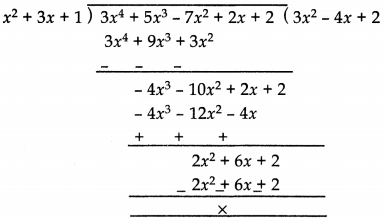
Using division algorithm
3x4 + 5x3 – 7x2 + 2x + 2 = (x2 + 3x + 1) (3x2 – 4x + 2) + 0
= (x2 + 3x + 1) (3x2 – 4x + 2)
Clearly, as remainder is 0, so the divisor x2 + 3x + 1 appear on R.H.S as factor of 3x4 + 5x3 7x2 + 2x + 2.
Question 3.
If one zero of the polynomial (a2 + 9)x2 + 13x + 6a is reciprocal of the other, find the value of a.
Answer:
Let α, 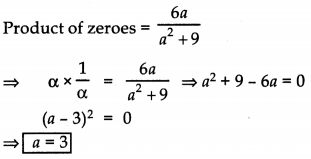
Question 4.
If α and β are zeroes of x2 + 7x + 12, then find the value of
Answer:
Here α + β = – 7, αβ = 12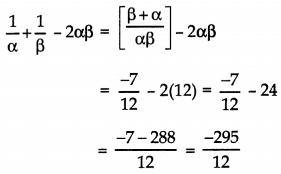
Question 5.
Find α-1 + β-1, if α and β are zereos of the polynomial 9x2 – 3x – 2.
Answer:
Since α and β are zereos of p(x) = 9x2 – 3x – 2
Question 6.
Find whether 2x3 – 1 is a factor of 2x5 + 10x4 + 2x2 + 5x + 1 or not.
Answer: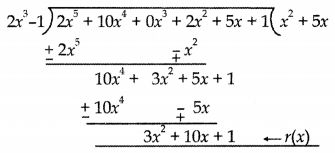
Since r(x) ≠ 0
∴ 2x3 – 1 is not a factor of given polynomial.
Question 7.
If α, β, γ are zeroes of the polynomial f(x) = x3 – 3x2 + 7x – 12, then find the value of (αβ)-1 + (βγ)-1 + (γα)-1.
Answer: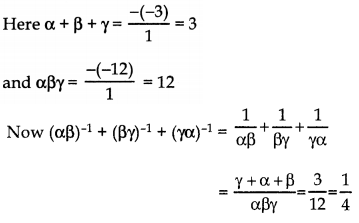
Question 8.
For what value of k is the polynomial x3 + kx2 + 3x – 18 is exactly divisible by (x – 3).
Answer:
If p(x) = x3 + kx2 + 3x – 18 is exactly divisible by (x – 3)
⇒ p(3) = 0 ⇒ (3)3 + k(3)2 + 3(3) – 18 = 0
⇒ 9k = – 18 ⇒ k = – 2
Polynomials Class 10 Extra Questions Short Answer Type-2
Question 1.
Find all the zeroes of 2x4 – 13x3 + 19x2 + 7x – 3, if you know that two of its zeroes are 2 + √3 and 2 – √3. [C.B.S.E. 2019]
Answer:
Given, x = (2 + √3) and x = (2 – √3) are zeroes of p(x) = 2x4 – 13x3 + 19x2 + 7x – 3
∴ (x – (2 + √3)) (x – (2 – √3)) is factor of p(x).
⇒ (x – 2 – √3) (x – 2 + √3) is factor of p(x).
= (x – 2)2 – (√5)2
= x2 – 4x + 4 – 3
= x2 – 4x + 1
Now, we divide p(x) by x2 – 4x + 1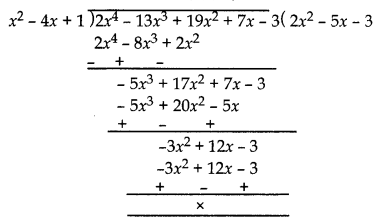
Now p(x) = (x2 – 4x + 1) (2x2 – 5x – 3)
∴ Other zeroes are given by
2x2 – 5x – 3 = 0
⇒ 2x2 – 6x + x – 3 = 0
⇒ 2x (x – 3) + 1 (x – 3) = 0
⇒ (2x + 1) (x – 3) = 0
⇒ 2x + 1 = 0 or x – 3 = 0
x = –
∴ Zeroes of given polynomial are
–
Question 2.
Find all the zeroes of 2x4 – 3x3 – 3x2 + 6x – 2, if it is given that two of its zeroes are 1 and
Answer:
Given: x = 1, x =
∴ (x – 1) and (x –
⇒ (x – 1) (2x – 1) = 2x2 – 3x + 1 is a factor of p(x).
Next, we divide p(x) by 2x2 – 3x + 1.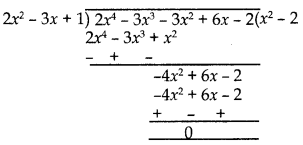
∴ p(x) = (2x2 – 3x + 1) (x2 – 2)
∴ Other zeroes are given by (x2 – 2) = 0
⇒ x = ±√2
∴ Zeroes of p(x) are – √2,
Question 3.
Find all zeros of the polynomial 3x3 + 10x2 – 9x – 4, if one of its zero is 1. [CBSE 2019]
Answer:
Let p(x) = 3x3 + 10x2 – 9x – 4
Since, 1 is a zero of p(x)
Therefore, (x – 1) is a factor of p(x)
Dividing p(x) by (x – 1), we have: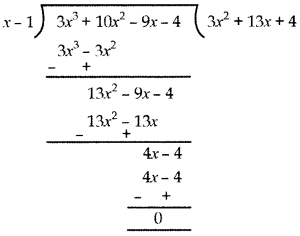
∴ By Division Algorithm,
p(x) = (3x2 + 13x + 4)(x – 1)
Zeroes of p(x) are given by p(x) = 0
⇒ (3x2 + 13x + 4)(x – 1) = 0
⇒ (3x2 + 12x + x + 4)(x – 1) = 0
⇒ {3x(x + 4) + 1 (x + 4)}(x – 1) = 0
⇒ (x + 4 )(3x + 1) (x – 1) = 0
⇒ x + 4 = 0
or 3x + 1 = 0 or x – 1 = 0
⇒ x = – 4, –
∴ Zeroes of p(x) are – 4, –
Question 4.
Divide the polynomial 3x3 – 6x2 – 20x + 14 by the polynomial x2 – 5x + 6 and verify the division algorithm. [CBSE Delhi 2016]
Answer: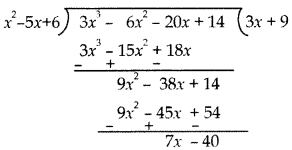
By division algorithm,
3x3 – 6x2 – 20x + 14 = (x2 – 5x + 6)(3x + 9) + (7x – 40)
or, p(x) = q(x) g(x) + r(x)
Question 5.
If α and β are the zeroes of a quadratic polynomial x2 – x – 2 then find the value of
Answer:
Comparing x2 – x – 2 with ax2 + bx + c, we have a = 1, b = – 1, c = -2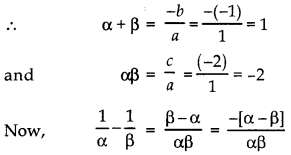
[∵ (α – β)2 = (α + β)2 – 4αβ
= (1)2 – 4 (- 2) = 1 + 8 = 9
∴ α – β = √9
⇒ (α – β) = ± 3]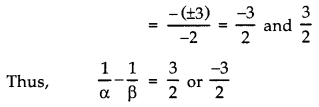
Question 6.
On dividing p(x) by a polynomial x – 1 – x2, the quotient and remainder were (x – 2) and 3 respectively. Find p(x).
Answer:
Here,
dividend = p(x)
Divisor, g(x) = (x – 1 – x2)
Quotient, q(x) = (x – 2)
Remainder, r(x) = 3
∵ Dividend = [Divisor × Quotient] + Remainder
∴ P(x) = [g(x) × q(x)] + r(x)
= [(x – 1 – x2) (x – 2)] + 3
= [x2 – x – x3 – 2x + 2 + 2x2] + 3
= 3x2 – 3x – x3 + 2 + 3
= – x3 + 3x2 – 3x + 5
Question 7.
Find the zeroes of the quadratic polynomial 5x2 – 4 – 8x and verify the relationship between the zeroes and the coefficients of the polynomial.
Answer:
p(x) = 5x2 – 4 – 8x = 5x2 – 8x – 4
= 5x2 – 10x + 2x – 4
= 5x(x – 2) + 2(x – 2)
= (x – 2) (5x + 2)
= 5(x – 2) (x +
∴ Zeroes of p(x) are 2 and –
Relationship Verification: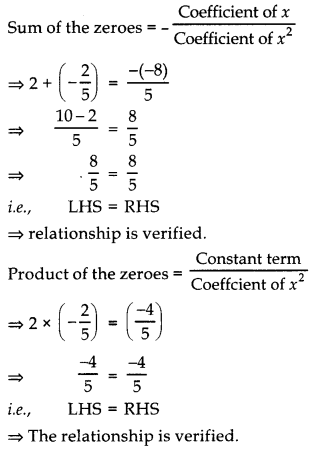
Polynomials Class 10 Extra Questions Long Answer Type 1
Question 1.
If the polynomial x4 + 2x3 + 8x2 + 12x + 18 is divided by another polynomial x2 + 5, the remainder comes out to be px + q. Find the values of p and q.
Answer: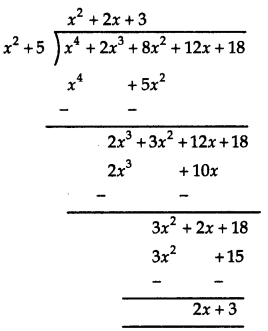
∴ Remainder = 2x + 3
Comparing 2x + 3 with px + q, we have
p = 2 and q = 3
Question 2.
If α, β, γ are the zeroes of p(x) = x3 – 7x2 + 11x – 7 find the value of
(i) α2 + β2 + γ2
(ii) α3 + β3 + γ3
Answer:
Comparing p(x) = x3 – 7x2 + 11x – 7 with standard cubic polynomial ax3 + bx2 + cx + d, we have
a = 1, b = – 7, c = 11, d = – 7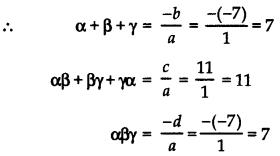
(i) Now, since (α + β + γ)2 = α2 + β2 + γ2 + 2(αβ + βγ + γα)
⇒ α2 + β2 + γ2 = (α + β + γ)2 – 2(αβ + βγ + γα)
= (7)2 – 2(11) = 49 – 22 = 27
(ii) Since
α3 + β3 + γ3 – 3αβγ = (α2 + β2 + γ2 – αβ – βγ – γα)
(α + β + γ)
= {(α + β + γ)2 – 2(αβ + βγ + γα) – (αβ + βγ + γα)}(α + β + γ)
⇒ α3 + β3 + γ3 = {(α + β + γ)2 – 3(αβ + βγ + γα)} (α + β + γ) + 3αβγ
= {72 – 3(11)} 7 + 3 × 7
= (49 – 33) 7 + 21
= 16 × 7 + 21 = 133.
Question 3.
Find the quadratic polynomial whose zeroes are 1 and – 3. Verify the relation between the coefficients and the zeroes of the polynomial.
Answer:
∵ The given zeroes are 1 and – 3.
∴ Sum of the zeroes = 1 + (- 3) = – 2
Product of the zeroes = 1 × (- 3) = – 3
A quadratic polynomial p(x) is given by
x2 – (sum of the zeroes) x + (product of the zeroes)
∴ The required polynomial is
x2 – (- 2)x + (-3)
⇒ x2 + 2x – 3
Verification of relationship
∵ Sum of the zeroes = –
∴ 1 + (- 3) =
⇒ – 2 = – 2
i.e., LHS = RHS
⇒ The sum of zeroes is verified.
∵ Product of the zeroes =
∴ 1 × (- 3) =
⇒ – 3 = – 3
i.e., L.H.S. = R.H.S.
⇒ The product of zeroes is verified.
Question 4.
What must be added to 6x5 + 5x4 + 11x3 – 3x2 + x + 1, so that the polynomial so obtained is exactly divisible by 3x2 – 2x + 4?
Answer: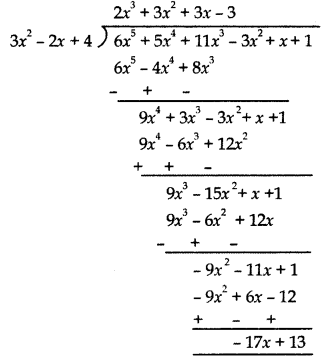
Therefore, we must add -(- 17x + 13),
i.e., 17x – 13.
Question 5.
Find the value of b for which the polynomial 2x3 + 9x2 – x – b is divisible by 2x + 3.
Answer: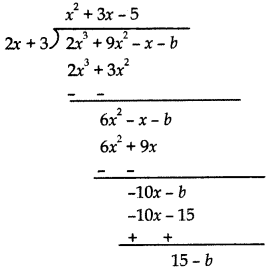
If the polynomial 2x3 + 9x2 – x – b is divisible by 2x + 3, then the remainder must be zero.
So, 15 – b = 0
⇒ b = 15
Question 6.
Find the zeroes of a cubic polynomial p(x) = 3x3 – 5x2 – 11x – 3 when it is given that product of two of its zeroes is -1.
Answer:
Here, p(x) = 3x3 – 5x2 – 11x – 3
On comparing p(x) with ax3 + bx2 + cx + d, we have;
a = 3, b = -5, c = -11, d = -3
Let α β γ be the zeroes of the given polynomial.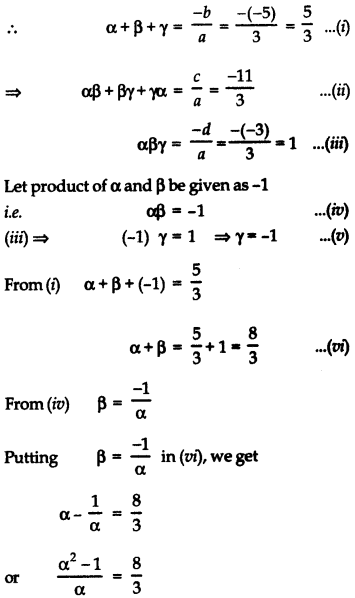
⇒ 3α2 – 3 = 8α
⇒ 3α2 – 8α – 3 = 0
⇒ 3α2 – 9α + α – 3 = 0
⇒ 3α(α – 3) + 1 (α – 3) = 0
⇒ (α – 3) (3α + 1) = 0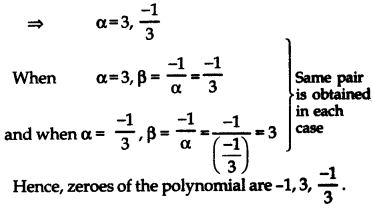
Polynomials Class 10 Extra Questions HOTS
Question 1.
If p and q are the zeroes of x2 + px + q, then find the values of p and q.
Answer:
p, q are the zeroes of x2 + px + q.
⇒ p + q = – p …………… (i)
and pq = q ……… (ii)
⇒ pq – q = 0
⇒ (p – 1)q = 0
⇒ either p = 1 or q = 0
When p = 1
⇒ 1 + q = – 1
⇒ q = – 2
When 9 = 0
⇒ p + 0 = – p
⇒ 2p = 0
⇒ p = 0
∴ p = 1, q = – 2 or p = q = 0.
Question 2.
If the zeroes of p(x) = ax3 + 3bx2 + 3cx + d are in A.P., prove that 2b3 – 3abc + a2d = 0
Answer:
Let α β γ be zeroes of p(x) = ax3 + 3bx2 + 3cx + d
But α, β, γ are in A.P.
So, take α = m – n, β = m, γ = m + n.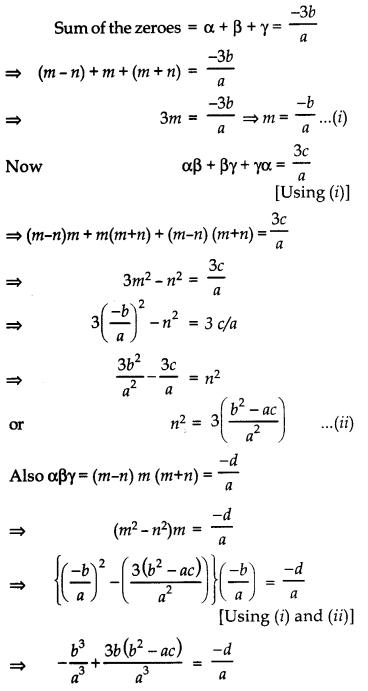
Multiplying throughout by a3, we get – b3 + 3b (b2 – ac) = – a2d
⇒ – b3 + 3b3 – 3abc + a2d = 0
or 2b3 – 3abc + a2d = 0
Note: Three numbers are said to be in Arithmetic Progression (A.P.). If each number is obtained by adding a constant to the previous number e.g. 3, 7, 11 are in A.P. Generally we take three numbers in A.P. as a – d, a, a + d.
It would be discussed in detail in Second term.
Question 3.
Find a relation between p and q, if one zero of x2 + px + q is 37 times the other.
Answer:
Let α, β be the zeroes of the polynomial
x2 + px + q
then α + β = – p, αβ = q
α = 37β (given)
∴ α + β = – p
⇒ 38β = – p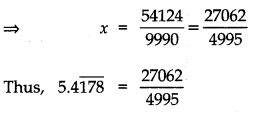
Multiple Choice Questions
Choose the correct option out of four given in each of the following:
Question 1.
The graph of p(x) is shown alongside. The number of zeroes of p(x) are: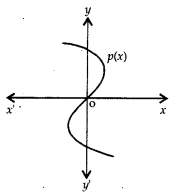
(a) 1
(b) 2
(c) 3
(d) 4
Answer:
(a) 1
Question 2.
If one zero of polynomial (k2 + 16) x2 + 13x + 8k is reciprocal of the other then k is equal to
(a) – 4
(b) +4
(c) 8
(d) 2
Answer:
(b) +4
Question 3.
If α and β are zeroes of the polynomial p(x) = x2 + mx + n, then a polynomial whose zeroes are
(a) nx2 + mx + 1
(b) mx2 + x + n
(c) x2 + nx + m
(d) x2 – mx + n
Answer:
(a) nx2 + mx + 1
Question 4.
If the graph of y = p(x) does not cut the x-axis at any point, then polynomial has
(a) one zero
(b) two zeroes
(c) no zeroes
(d) infinite no. of zeroes
Answer:
(c) no zeroes
Question 5.
Sum of the zeroes of the polynomial p(x) = – 3x2 + k is
(a)
(b)
(c) 0
(d) k
Answer:
(c) 0
Question 6.
If x – 1 is a factor of p(x) = kx2 – √2x + 1, then the value of k is
(a) √2 – 1
(b) – √2 + 1
(c) – 1 – √2
(d) 1 + √2
Answer:
(a) √2 – 1
Question 7.
Number of zeroes of a polynomial of degree n is
(a) equal to n
(b) less than n
(c) greater than n
(d) less than or equal to n
Answer:
(d) less than or equal to n
Question 8.
Zeroes of the polynomial p(x) = 2x2 – 9 – 3x are
(a) 3,
(b) –
(c) 2, 3
(d) 9,
Answer:
(b) –
Question 9.
If (α – β), α, (α + β) are zeroes of the polynomial p(x) = 2x3 – 16x2 + 15x – 2, value of α is
(a) 8
(b) 0
(c)
(d)
Answer:
(d)
Question 10.
If n represents number of real zeroes for the polynomial ax3 + bx2 + cx + d then which of the following inequality is valid
(a) 0 < n < 3
(b) 0 < n < 3
(c) 0 < n < 3
(d) 0 < n < 3
Answer:
(c) 0 < n < 3
Question 11.
Number of quadratic polynomials having – 2 and – 5 as their two zeroes is :
(a) one
(b) two
(c) three
(d) infinite
Answer:
(d) infinite
Question 12.
If α, β, γ are zeroes of the polynomial p (x) such that α + β + γ = 2, αβ + βγ + γα = 5, αβγ = – 7, then p(x) is:
(a) x3 – 2x2 + 5x – 7
(b) x3 + 2x2 – 5x + 7
(c) x3 – 2x2 – 5x – 7
(d) x3 – 2x2 + 5x + 7
Answer:
(d) x3 – 2x2 + 5x + 7
Question 13.
If the sum of products of zeroes taken two at a time of polynomial p(x) = x3 – 5×2 + cx + 8 is 2 then the value of c is
(a) 2
(b) – 2
(c) 8
(d) – 5
Answer:
(a) 2
Question 14.
The division algorithm states that given any polynomial p(x) and any non-zero polynomial g(x) there are polynomial q(x) and r(x) such that p(x) = g(x) q{x) + r(x), where r(x) is
(a) either = 0 or deg. r(x) < deg. g(x) (b) either = 0 or deg. r(x) > deg. g(x)
(c) a linear polynomial or deg. r(x) = deg. g(x)
(d) either = 0 or deg. r(x) < deg. g(x)
Answer:
(d) either = 0 or deg. r(x) < deg. g(x)
Question 15.
If divisor, quotient and remainder are x +
(a) 3x2 + x + 1
(b) 3x2 – x – 1
(c) 3x2 + x – 1
(d) 3x2 – x + 1
Answer:
(c) 3x2 + x – 1
Fill in the blanks
Question 1.
The zeroes of the polynomial x2 – 49 are ______________ .
Answer:
± 7
Question 2.
The quadratic polynomial, whose sum and product of zeroes are 4 and – 5 respectively is _____________ .
Answer:
k(x2 – 4x – 5)
Question 3.
The value of the polynomial p(x) = 4x2 – 7 at x = – 2 is _______________ .
Answer:
9
Question 4.
Product of zeroes of a polynomial p(x) = 6x2 – 7x – 3 is _______________ .
Answer:
–
Question 5.
If one zero of 3x2 – 8x +2k + 1 is seven times the other, then k is _________________.
Answer:
Question 6.
The degree of the constant polynomial is _______________ .
Answer:
zero
Question 7.
A real number k is a zero of the polynomial p(x) if and only if _______________.
Answer:
p(k) = 0
Question 8.
The shape of the graph of a cubic polynomial is _______________ .
Answer:
not fixed
Question 9.
If α, β and γ are the zeroes of the cubic polynomial px3 + qx2 + rx + s; a ≠ 0, then α + β + γ = ____________ , αβ + βγ + γα = _____________ and αβγ = ___________.
Answer:
Question 10.
The standard form of the polynomial x3 – x6 + x5 + 2x2 – x4 – 5 is ______________ .
Answer:
x6 + x5 – x4 + x3 + 2x2 – 5 or – 5 + 2x2 + x3 – x4 + x5 – x6

You can also download Maths NCERT Solutions Class 10 to help you to revise complete syllabus and score more marks in your examinations.
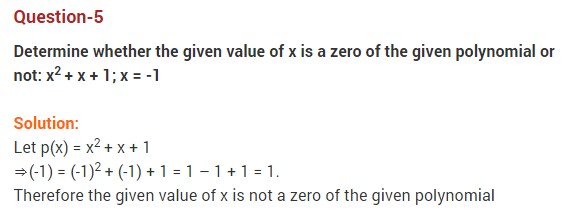
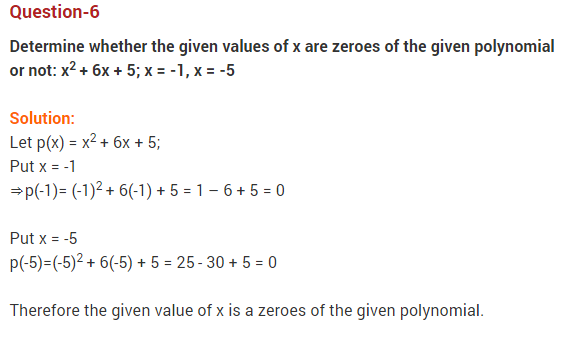
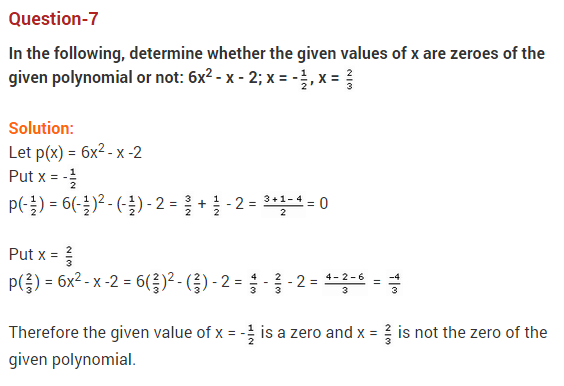
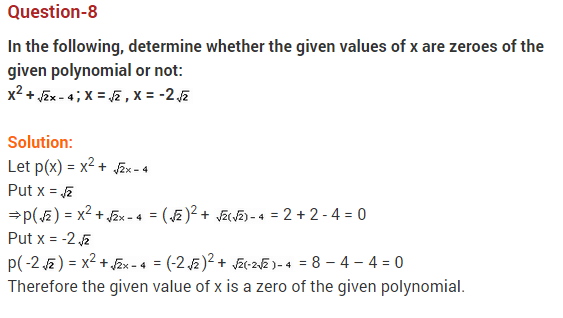
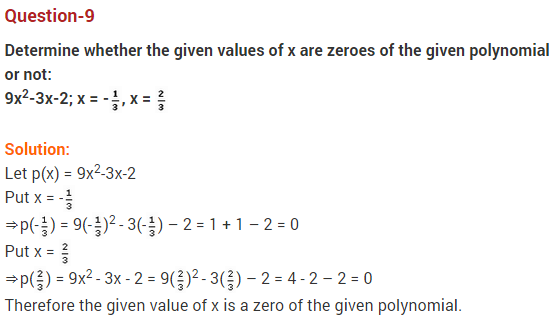
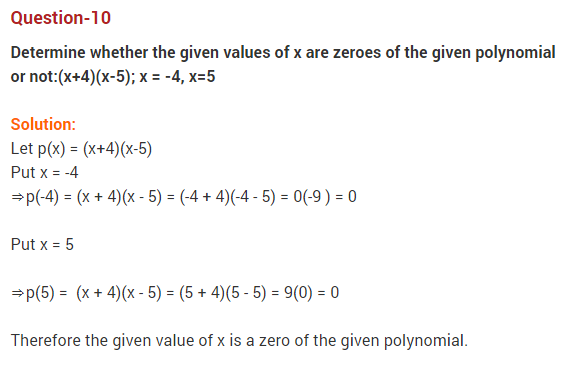
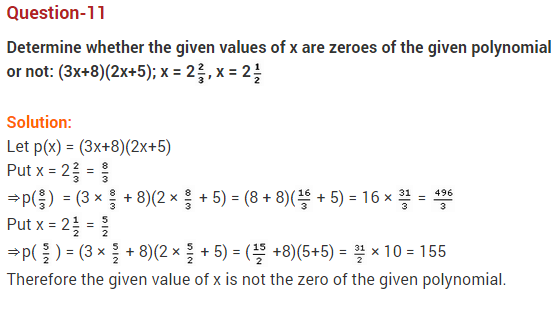
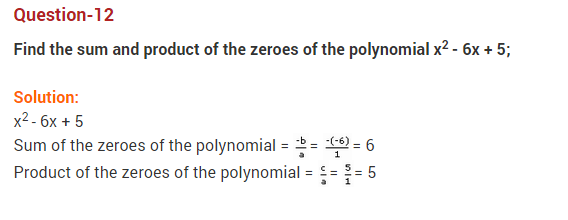
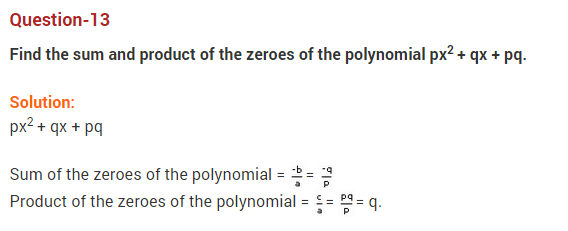
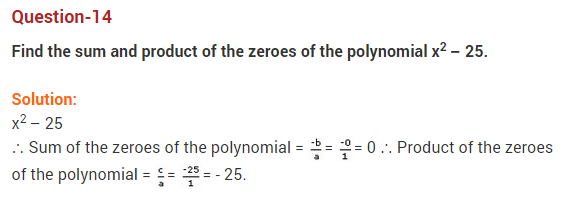
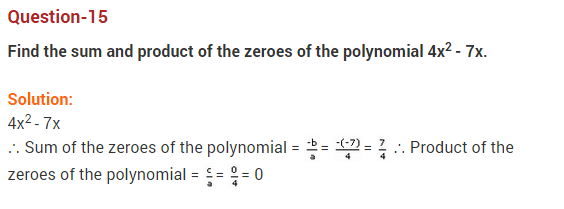
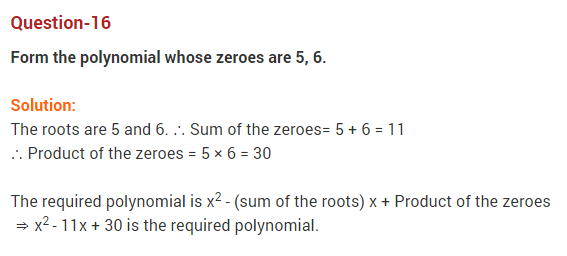
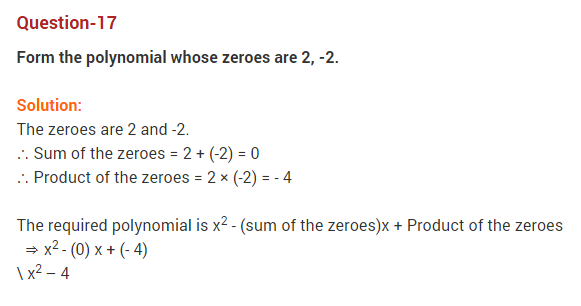
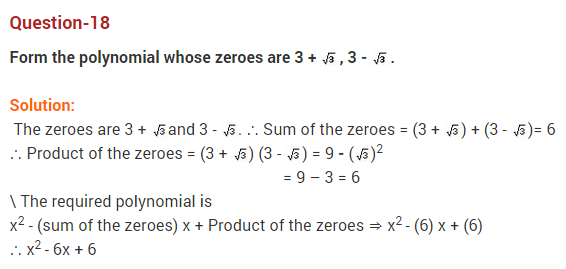
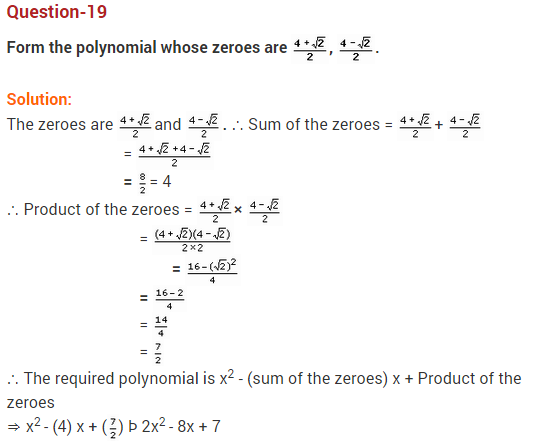
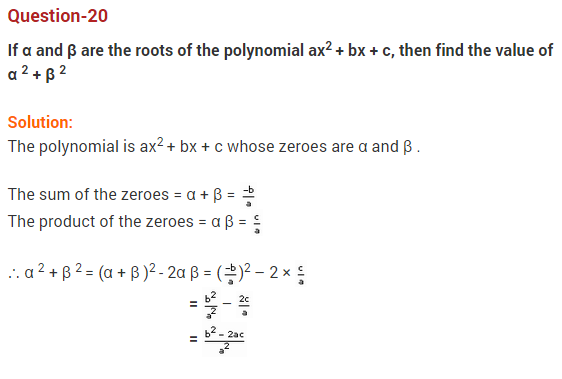
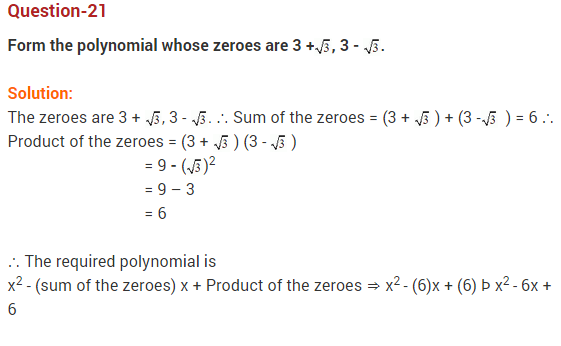
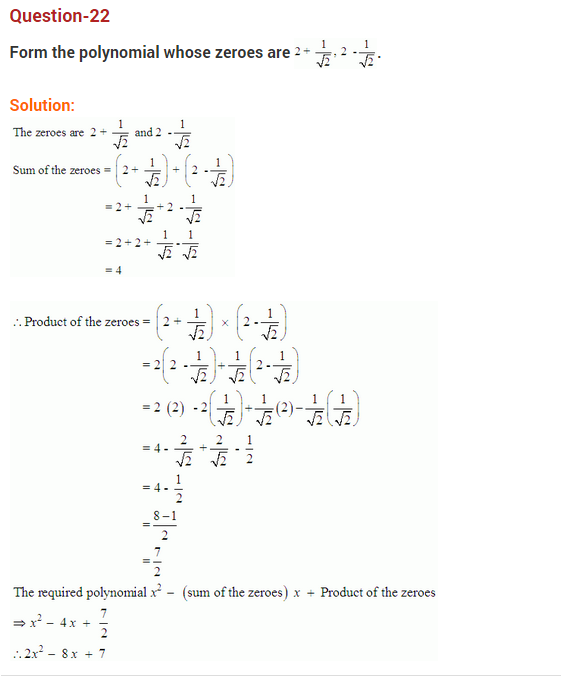
Class 10 Maths Chapter 2 Ex 2.2 NCERT Solutions
Ex 2.2 Class 10 Maths Question 1.
Find the zeroes of the following quadratic polynomials and verify the relationship between the zeroes and their coefficients:
(i) x2 – 2x – 8
(ii) 4s2 – 4s + 1
(iii) 6x2 – 3 – 7x
(iv) 4u2 + 8u
(v) t2 – 15
(vi) 3x2 – x – 4
Solution:
Ex 2.2 Class 10 Maths Question 2.
Find a quadratic polynomial each with the given numbers as the sum and product of zeroes respectively:
Solution:
NCERT Solutions for Class 10 Maths Chapter 2 Polynomial (Hindi Medium) Ex 2.2














Class 10 Maths Chapter 2 Ex 2.3
Ex 2.3 Class 10 Maths Question 1.
Divide the polynomial p(x) by the polynomial g(x) and find the quotient and remainder in each of the following:
(i) p(x) = x3 – 3x2 + 5x – 3, g(x) = x2 – 2
(ii) p(x) = x4 – 3x2 + 4x + 5, g(x) = x2 + 1 – x
(iii) p(x) = x4– 5x + 6, g(x) = 2 – x2
Solution:
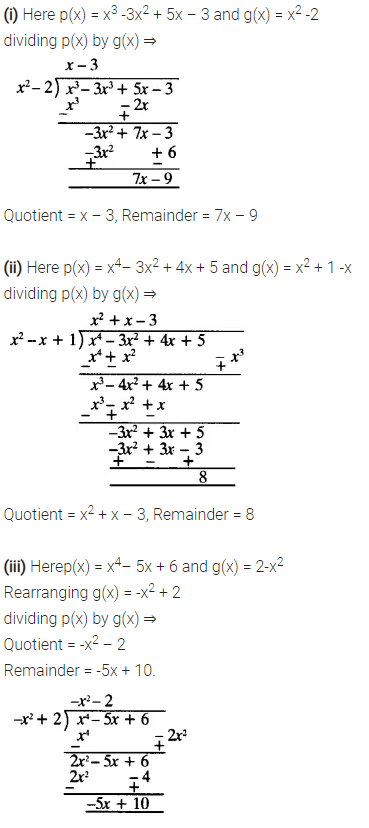
Ex 2.3 Class 10 Maths Question 2.
Check whether the first polynomial is a factor of the second polynomial by dividing the second polynomial by the first polynomial.
(i) t2 – 3, 2t4 + 3t3 – 2t2– 9t – 12
(ii) x2 + 3x + 1, 3x4 + 5x3 – 7x2 + 2x + 2
(iii) x2 + 3x + 1, x5 – 4x3 + x2 + 3x + 1
Solution: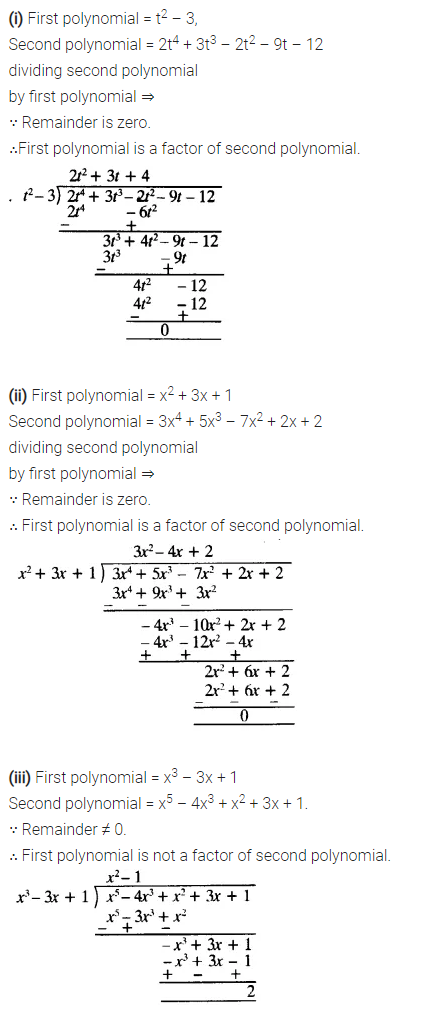
Ex 2.3 Class 10 Maths Question 3.
Obtain all other zeroes of 3x4 + 6x3 – 2x2 – 10x – 5, if two of its zeroes are and
Solution: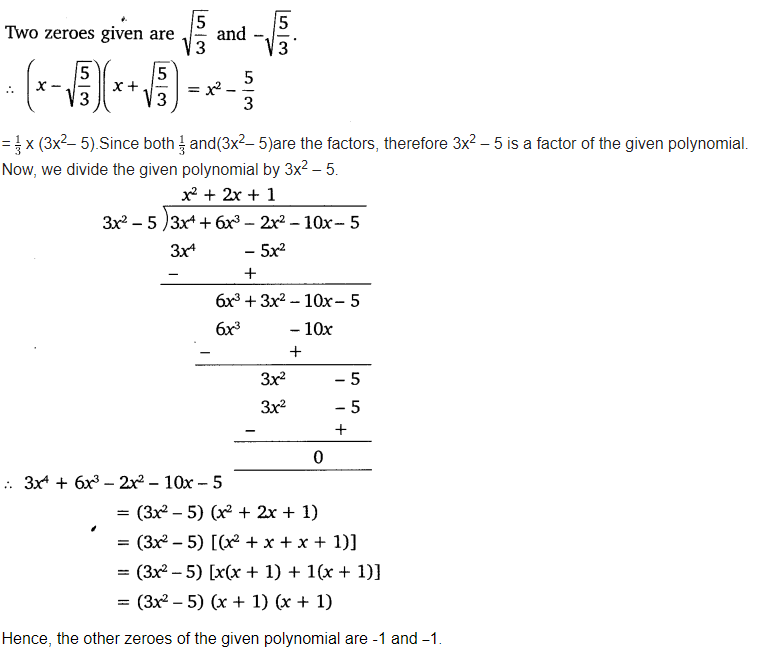
Ex 2.3 Class 10 Maths Question 4.
On dividing x3 – 3x2 + x + 2bya polynomial g(x), the quotient and remainder were x – 2 and -2x + 4 respectively. Find g(x).
Solution: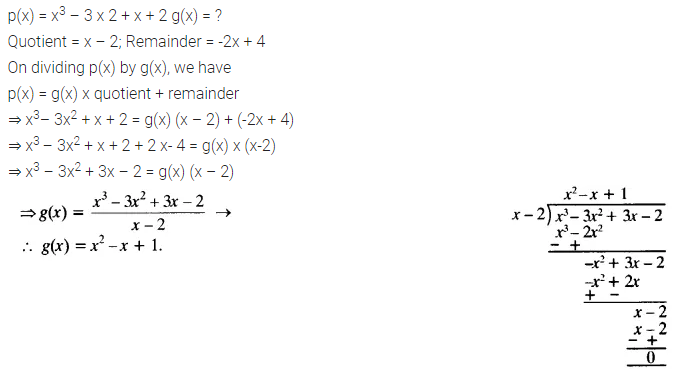
Ex 2.3 Class 10 Maths Question 5.
Give examples of polynomials p(x), g(x), q(x) and r(x), which satisfy the division algorithm and:
(i) deg p(x) = deg q(x)
(ii) deg q(x) = deg r(x)
(iii) deg r(x) = 0
Solution: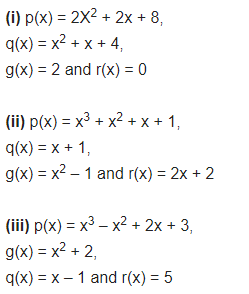
NCERT Solutions for Class 10 Maths Chapter 2 Polynomial (Hindi Medium) Ex 2.3
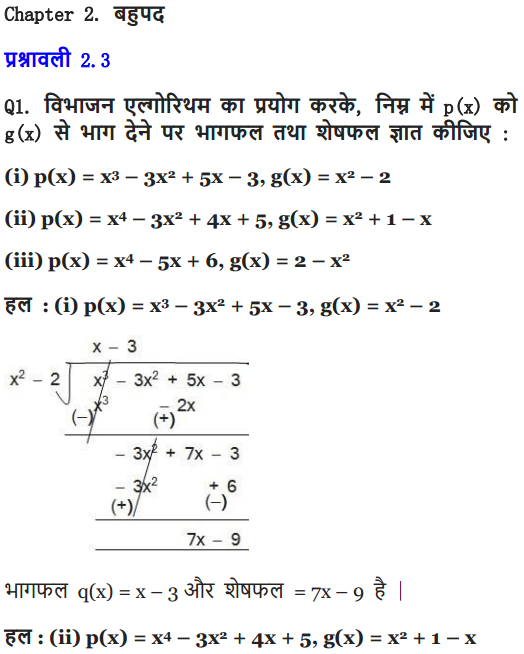
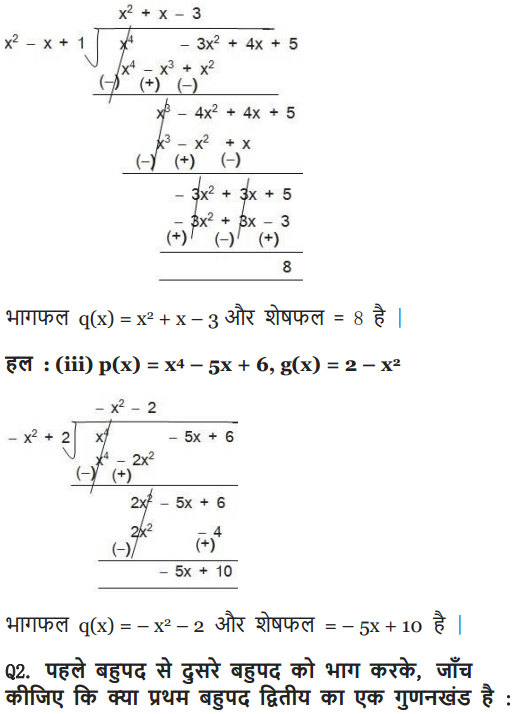
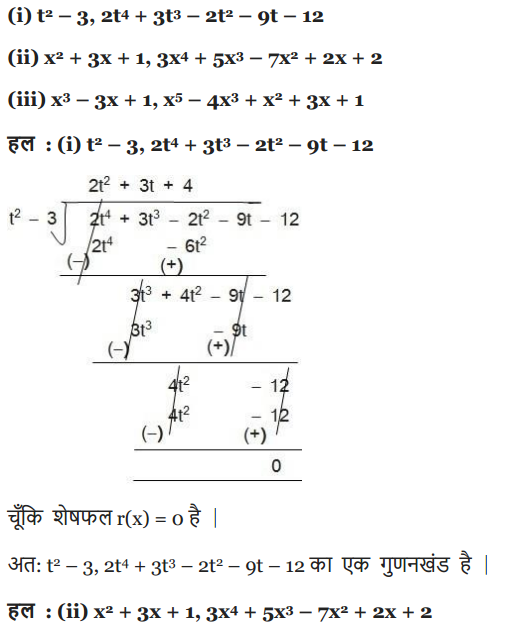
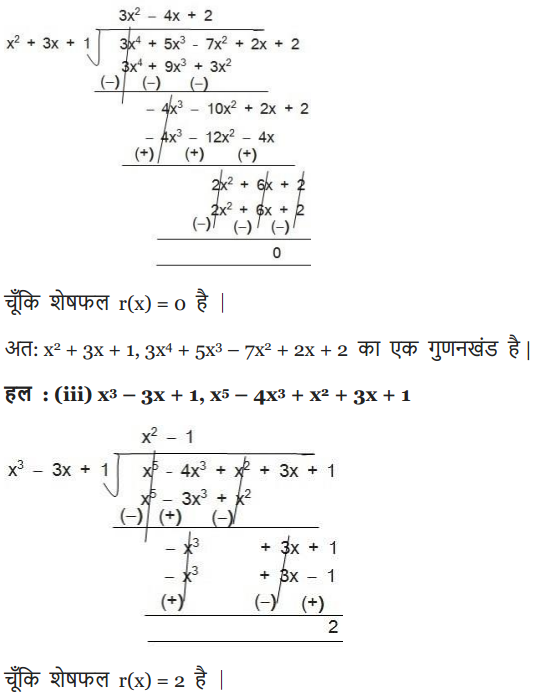
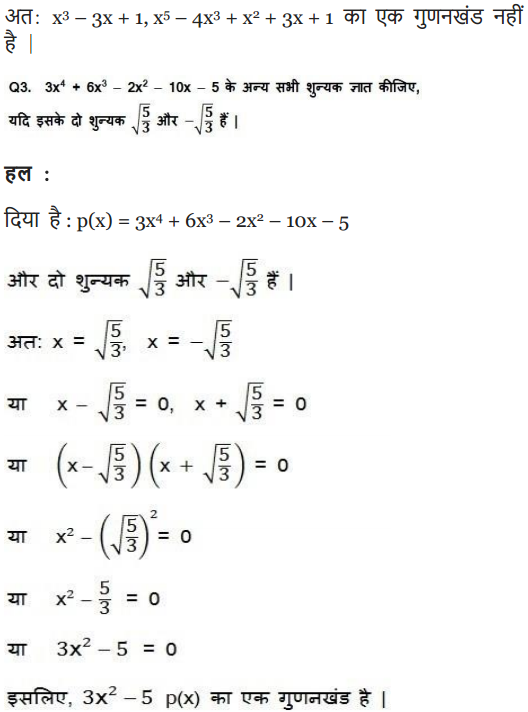
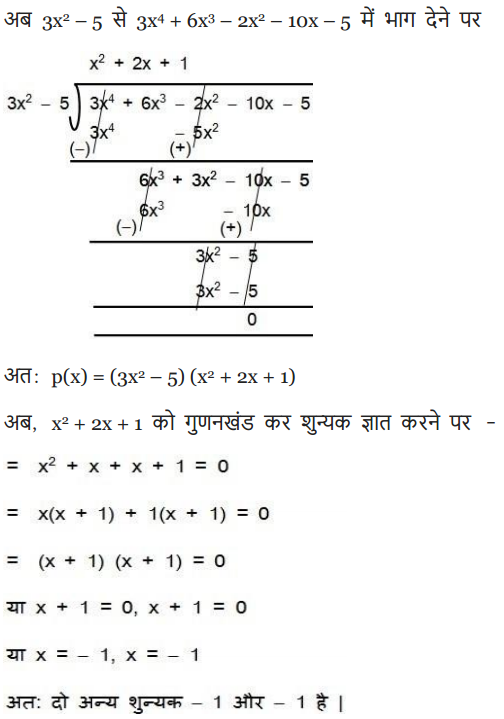
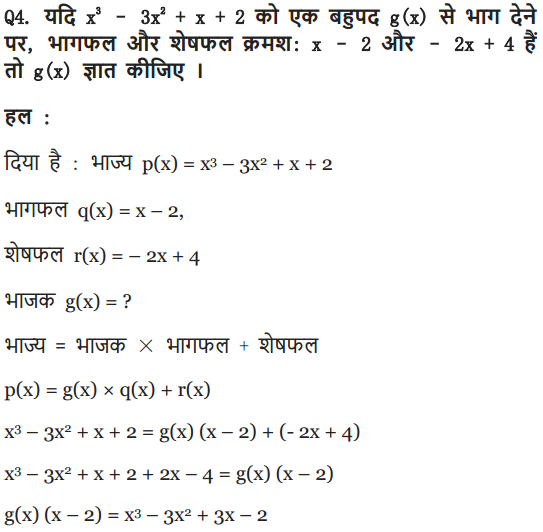
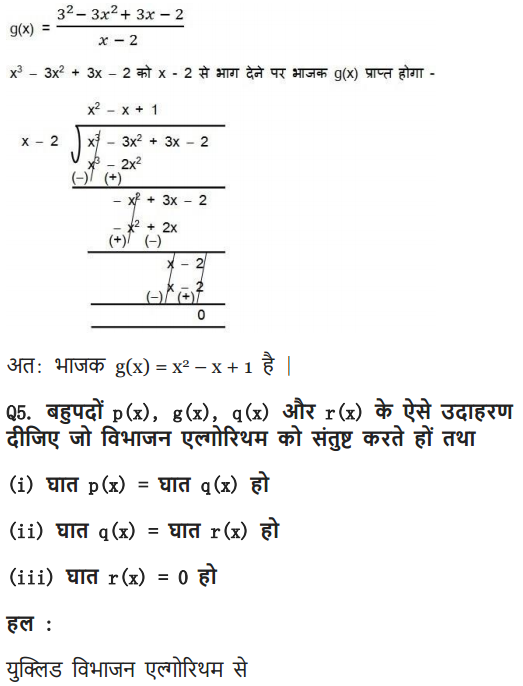
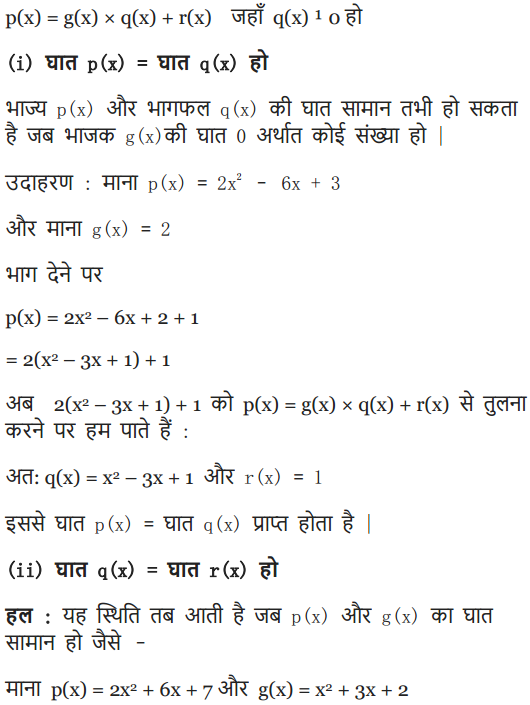
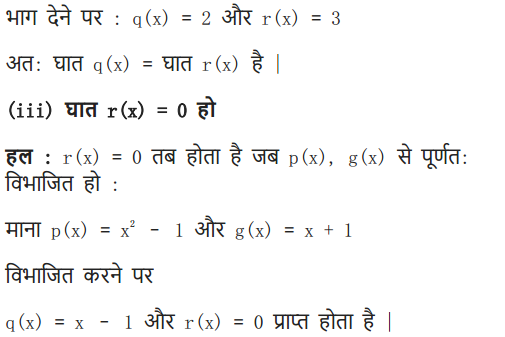
Class 10 Maths Chapter 2 Ex 2.4
Ex 2.4 Class 10 Maths Question 1.
Verify that the numbers given alongside of the cubic polynomials below are their zeroes. Also, verify the relationship between the zeroes and the coefficients in each case:
(i) 2x3 + x2 – 5x + 2;
(ii) x3 – 4x2 + 5x – 2; 2, 1, 1
Solution: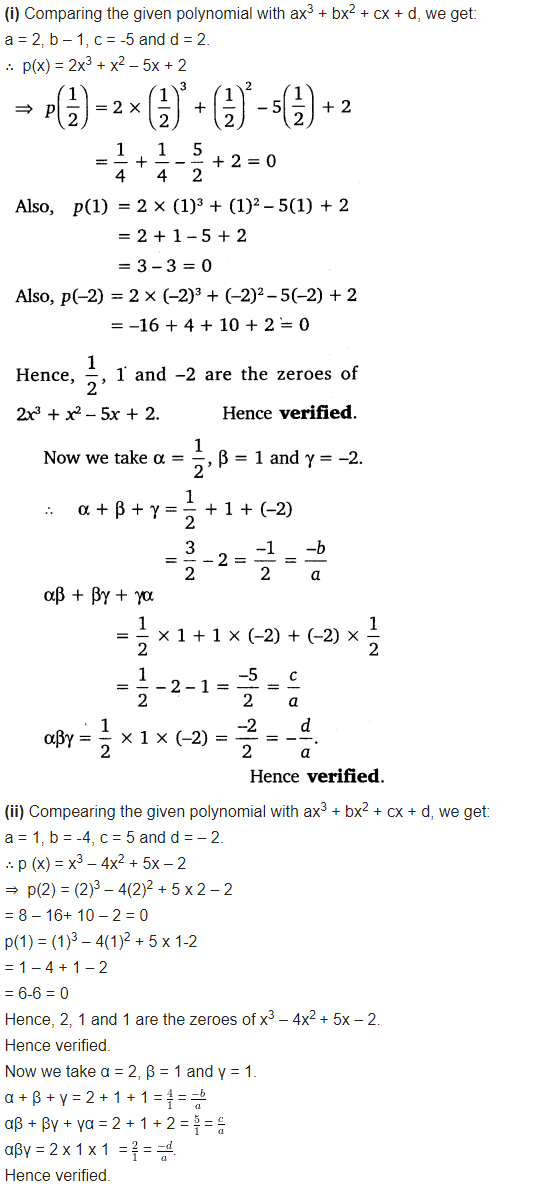
Ex 2.4 Class 10 Maths Question 2.
Find a cubic polynomial with the sum, some of the product of its zeroes taken two at a time, and the product of its zeroes as 2, -7, -14 respectively.
Solution: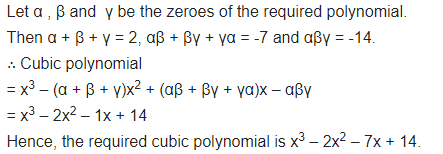
Ex 2.4 Class 10 Maths Question 3.
If the zeroes of the polynomial x3 – 3x2 + x + 1 are a-b, a, a + b, find a and b.
Solution: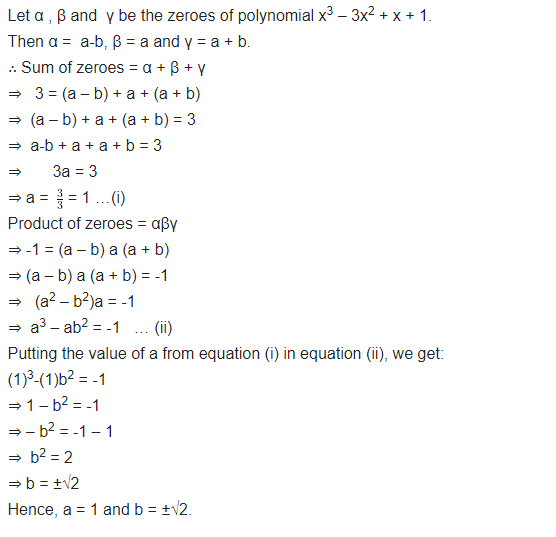
Ex 2.4 Class 10 Maths Question 4.
If two zeroes of the polynomial x4 – 6x3 – 26x2 + 138x – 35 are 2 ± √3, find other zeroes.
Solution: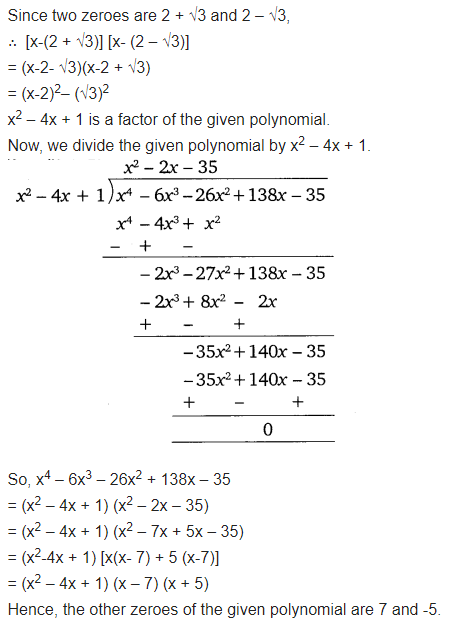
Ex 2.4 Class 10 Maths Question 5.
If the polynomial x4 – 6x3 + 16x2 – 25x + 10 is divided by another polynomial x2 – 2x + k, the remainder comes out to be x + a, find k and a.
Solution: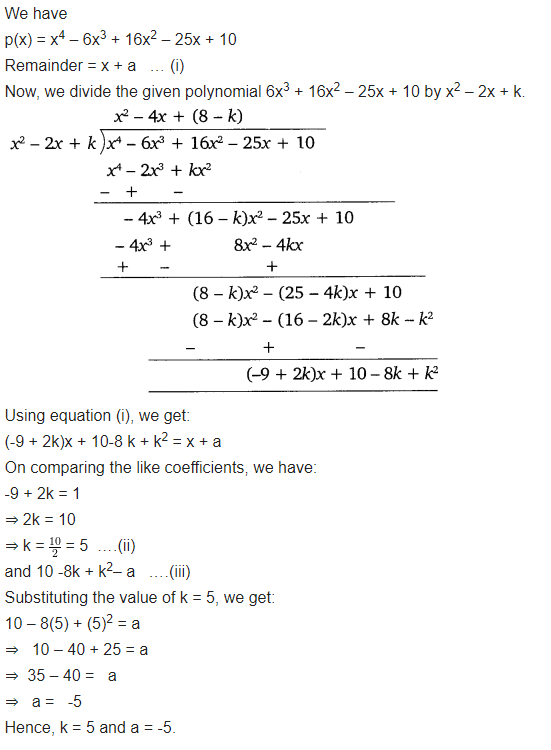
NCERT Solutions for Class 10 Maths Chapter 2 Polynomial (Hindi Medium) Ex 2.4
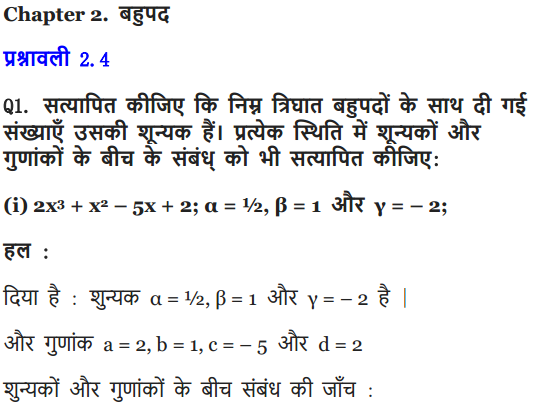
Polynomials Class 10 Important Questions Very Short Answer (1 Mark)
Question 1.
If the sum of zeroes of the quadratic polynomial 3x2 – kx + 6 is 3, then find the value of k. (2012)
Solution:
Here a = 3, b = -k, c = 6
Sum of the zeroes, (α + β) =
⇒
⇒ k = 9
Question 2.
If α and β are the zeroes of the polynomial ax2 + bx + c, find the value of α2 + β2. (2013)
Solution: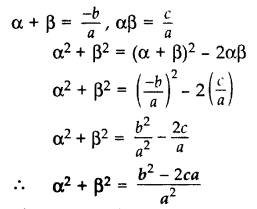
Question 3.
If the sum of the zeroes of the polynomial p(x) = (k2 – 14) x2 – 2x – 12 is 1, then find the value of k. (2017 D)
Solution:
p(x) = (k2 – 14) x2 – 2x – 12
Here a = k2 – 14, b = -2, c = -12
Sum of the zeroes, (α + β) = 1 …[Given]
⇒
⇒
⇒ k2 – 14 = 2
⇒ k2 = 16
⇒ k = ±4
Question 4.
If α and β are the zeroes of a polynomial such that α + β = -6 and αβ = 5, then find the polynomial. (2016 D)
Solution:
Quadratic polynomial is x2 – Sx + P = 0
⇒ x2 – (-6)x + 5 = 0
⇒ x2 + 6x + 5 = 0
Question 5.
A quadratic polynomial, whose zeroes are -4 and -5, is …. (2016 D)
Solution:
x2 + 9x + 20 is the required polynomial.
Polynomials Class 10 Important Questions Short Answer-I (2 Marks)
Question 6.
Find the condition that zeroes of polynomial p(x) = ax2 + bx + c are reciprocal of each other. (2017 OD)
Solution:
Let α and
P(a) = ax2 + bx + c …(given)
Product of zeroes =
⇒ α ×
⇒ 1 =
⇒ a = c (Required condition)
Coefficient of x2 = Constant term
Question 7.
Form a quadratic polynomial whose zeroes are 3 + √2 and 3 – √2. (2012)
Solution:
Sum of zeroes,
S = (3 + √2) + (3 – √2) = 6
Product of zeroes,
P = (3 + √2) x (3 – √2) = (3)2 – (√2)2 = 9 – 2 = 7
Quadratic polynomial = x2 – Sx + P = x2 – 6x + 7
Question 8.
Find a quadratic polynomial, the stun and product of whose zeroes are √3 and
Solution:
Sum of zeroes, (S) = √3
Product of zeroes, (P) =
Quadratic polynomial = x2 – Sx + P
Question 9.
Find a quadratic polynomial, the sum and product of whose zeroes are 0 and -√2 respectively. (2015)
Solution:
Quadratic polynomial is
x2 – (Sum of zeroes) x + (Product of zeroes)
= x2 – (0)x + (-√2)
= x2 – √2
Question 10.
Find the zeroes of the quadratic polynomial √3 x2 – 8x + 4√3. (2013)
Solution: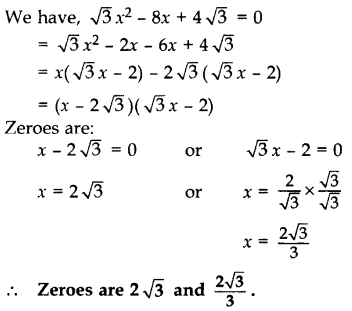
Question 11.
If the zeroes of the polynomial x2 + px + q are double in value to the zeroes of 2x2 – 5x – 3, find the value of p and q. (2012)
Solution:
We have, 2x2 – 5x – 3 = 0
= 2x2 – 6x + x – 3
= 2x(x – 3) + 1(x – 3)
= (x – 3) (2x + 1)
Zeroes are:
x – 3 = 0 or 2x + 1 = 0
⇒ x = 3 or x =
Since the zeroes of required polynomial is double of given polynomial.
Zeroes of the required polynomial are:
3 × 2, (
Sum of zeroes, S = 6 + (-1) = 5
Product of zeroes, P = 6 × (-1) = -6
Quadratic polynomial is x2 – Sx + P
⇒ x2 – 5x – 6 …(i)
Comparing (i) with x2 + px + q
p = -5, q = -6
Question 12.
Can (x – 2) be the remainder on division of a polynomial p(x) by (2x + 3)? Justify your answer. (2016 OD)
Solution:
In case of division of a polynomial by another polynomial, the degree of the remainder (polynomial) is always less than that of the divisor. (x – 2) can not be the remainder when p(x) is divided by (2x + 3) as the degree is the same.
Question 13.
Find a quadratic polynomial whose zeroes are
Solution: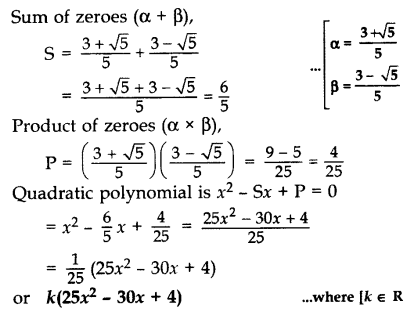
Question 14.
Find the quadratic polynomial whose zeroes are -2 and -5. Verify the relationship between zeroes and coefficients of the polynomial. (2013)
Solution:
Sum of zeroes, S = (-2) + (-5) = -7
Product of zeroes, P = (-2)(-5) = 10
Quadratic polynomial is x2 – Sx + P = 0
= x2 – (-7)x + 10
= x2 + 7x + 10
Verification:
Here a = 1, b = 7, c = 10
Sum of zeroes = (-2) + (-5) = 7

Question 15.
Find the zeroes of the quadratic polynomial 3x2 – 75 and verify the relationship between the zeroes and the coefficients. (2014)
Solution:
We have, 3x2 – 75
= 3(x2 – 25)
= 3(x2 – 52)
= 3(x – 5)(x + 5)
Zeroes are:
x – 5 = 0 or x + 5 = 0
x = 5 or x = -5
Verification:
Here a = 3, b = 0, c = -75
Sum of the zeroes = 5 + (-5) = 0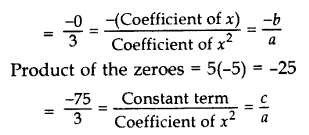
Question 16.
Find the zeroes of p(x) = 2x2 – x – 6 and verify the relationship of zeroes with these co-efficients. (2017 OD)
Solution:
p(x) = 2x2 – x – 6 …[Given]
= 2x2 – 4x + 3x – 6
= 2x (x – 2) + 3 (x – 2)
= (x – 2) (2x + 3)
Zeroes are:
x – 2 = 0 or 2x + 3 = 0
x = 2 or x =
Verification:
Here a = 2, b = -1, c = -6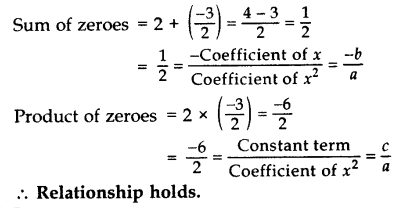
Question 17.
What must be subtracted from the polynomial f(x) = x4 + 2x3 – 13x2 – 12x + 21 so that the resulting polynomial is exactly divisible by x2 – 4x + 3? (2012, 2017 D)
Solution: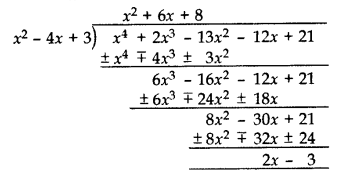
(2x – 3) should be subtracted from x4 + 2x3 – 13x2 – 12x + 21.
Polynomials Class 10 Important Questions Short Answer-II (3 Marks)
Question 18.
Verify whether 2, 3 and
Solution:
p(x) = 2x3 – 11x2 + 17x – 6
When x = 2,
p(2) = 2(2)3 – 11(2)2 + 17(2) – 6 = 16 – 44 + 34 – 6 = 0
When x = 3, p(3) = 2(3)3 – 11(3)2 + 17(3) – 6 = 54 – 99 + 51 – 6 = 0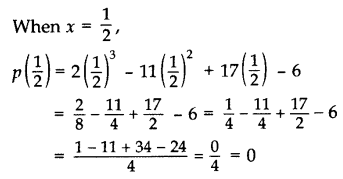
Yes, x = 2, 3 and
Question 19.
Show that
Solution:
Let P(x) = 4x2 + 4x – 3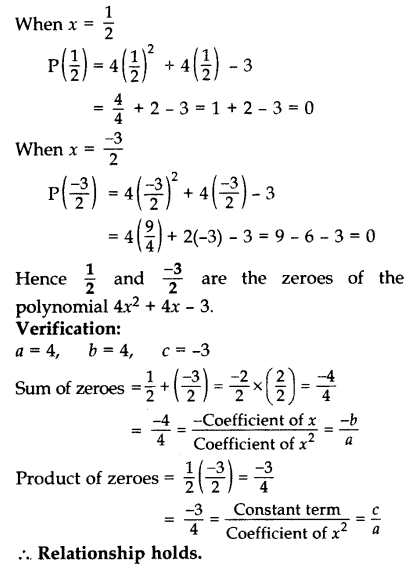
Question 20.
Find a quadratic polynomial, the sum and product of whose zeroes are -8 and 12 respectively. Hence find the zeroes. (2014)
Solution:
Let Sum of zeroes (α + β) = S = -8 …[Given]
Product of zeroes (αβ) = P = 12 …[Given]
Quadratic polynomial is x2 – Sx + P
= x2 – (-8)x + 12
= x2 + 8x + 12
= x2 + 6x + 2x + 12
= x(x + 6) + 2(x + 6)
= (x + 2)(x + 6)
Zeroes are:
x + 2 = 0 or x + 6 = 0
x = -2 or x = -6
Question 21.
Find a quadratic polynomial, the sum and product of whose zeroes are 0 and
Solution:
Quadratic polynomial = x2 – (Sum)x + Product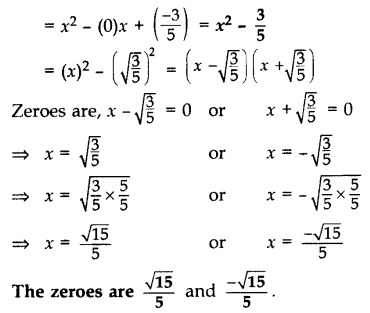
Question 22.
Find the zeroes of the quadratic polynomial 6x2 – 3 – 7x and verify the relationship between the zeroes and the coefficients of the polynomial. (2015, 2016 OD)
Solution:
We have, 6x2 – 3 – 7x
= 6x2 – 7x – 3
= 6x2 – 9x + 2x – 3
= 3x(2x – 3) + 1(2x – 3)
= (2x – 3) (3x + 1)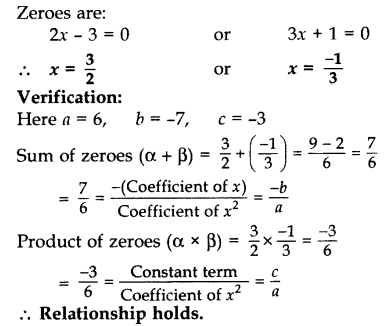
Question 23.
Find the zeroes of the quadratic polynomial f(x) = x2 – 3x – 28 and verify the relationship between the zeroes and the co-efficients of the polynomial. (2012, 2017 D)
Solution:
p(x) = x2 – 3x – 28
= x2 – 7x + 4x – 28
= x(x – 7) + 4(x – 7)
= (x – 7) (x + 4)
Zeroes are:
x – 7 = 0 or x + 4 = 0
x = 7 or x = -4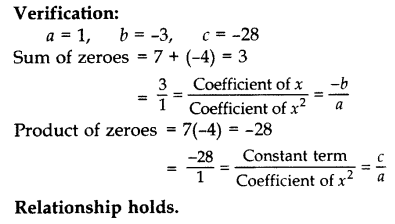
Question 24.
If α and β are the zeroes of the polynomial 6y2 – 7y + 2, find a quadratic polynomial whose zeroes are
Solution:
Given: 6y2 – 7y + 2
Here a = 6, b = -7, c = 2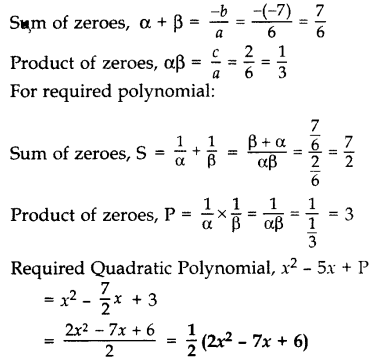
Question 25.
Divide 3x2 + 5x – 1 by x + 2 and verify the division algorithm. (2013 OD)
Solution: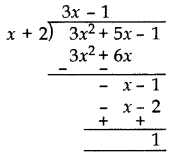
Quotient = 3x – 1
Remainder = 1
Verification:
Divisor × Quotient + Remainder
= (x + 2) × (3x – 1) + 1
= 3x2 – x + 6x – 2 + 1
= 3x2 + 5x – 1
= Dividend
Question 26.
On dividing 3x3 + 4x2 + 5x – 13 by a polynomial g(x) the quotient and remainder were 3x +10 and 16x – 43 respectively. Find the polynomial g(x). (2017 OD)
Solution:
Let 3x3 + 4x2 + 5x – 13 = P(x)
q(x) = 3x + 10, r(x) = 16x – 43 …[Given]
As we know, P(x) = g(x) . q(x) + r(x)
3x3 + 4x2 + 5x – 13 = g(x) . (3x + 10) + (16x – 43)
3x3 + 4x2 + 5x – 13 – 16x + 43 = g(x) . (3x + 10)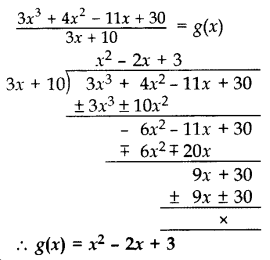
Question 27.
Check whether polynomial x – 1 is a factor of the polynomial x3 – 8x2 + 19x – 12. Verify by division algorithm. (2014)
Solution:
Let P(x) = x3 – 8x2 + 19x – 12
Put x = 1
P(1) = (1)3 – 8(1)2 + 19(1) – 12
= 1 – 8 + 19 – 12
= 20 – 20
= 0
Remainder = 0
(x – 1) is a facter of P(x).
Verification:
Since remainder = 0
(x – 1) is a factor of P(x).
Polynomials Class 10 Important Questions Long Answer (4 Marks)
Question 28.
Divide 4x3 + 2x2 + 5x – 6 by 2x2 + 1 + 3x and verify the division algorithm. (2013)
Solution: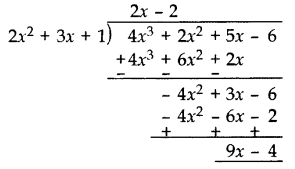
Quotient = 2x – 2
Remainder = 9x – 4
Verification:
Divisor × Quotient + Remainder
= (2x2 + 3x + 1) × (2x – 2) + 9x – 4
= 4x3 – 4x2 + 6x2 – 6x + 2x – 2 + 9x – 4
= 4x3 + 2x2 + 5x – 6
= Dividend
Question 29.
Given that x – √5 is a factor of the polynomial x3 – 3√5 x2 – 5x + 15√5, find all the zeroes of the polynomial. (2012, 2016)
Solution:
Let P(x) = x3 – 3√5 x2 – 5x + 15√5
x – √5 is a factor of the given polynomial.
Put x = -√5,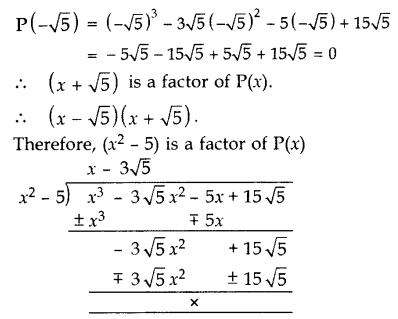
Other zero:
x – 3√5 = 0 ⇒ x = 3√5
All the zeroes of P(x) are -√5, √5 and 3√5.
Question 30.
If a polynomial x4 + 5x3 + 4x2 – 10x – 12 has two zeroes as -2 and -3, then find the other zeroes. (2014)
Solution:
Since two zeroes are -2 and -3.
(x + 2)(x + 3) = x2 + 3x + 2x + 6 = x2 + 5x + 6
Dividing the given equation with x2 + 5x + 6, we get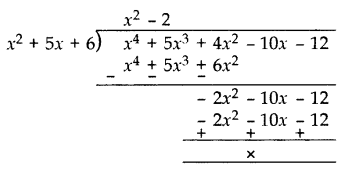
x4 + 5x3 + 4x2 – 10x – 12
= (x2 + 5x + 6)(x2 – 2)
= (x + 2)(x + 3)(x – √2 )(x + √2 )
Other zeroes are:
x – √2 = 0 or x + √2 = 0
x = √2 or x = -√2
Question 31.
Find all the zeroes of the polynomial 8x4 + 8x3 – 18x2 – 20x – 5, if it is given that two of its zeroes are
Solution: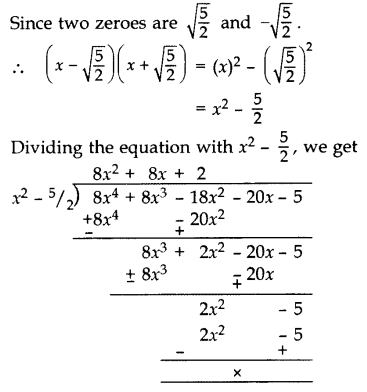
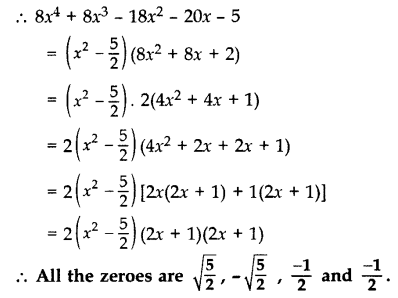
Question 32.
If p(x) = x3 – 2x2 + kx + 5 is divided by (x – 2), the remainder is 11. Find k. Hence find all the zeroes of x3 + kx2 + 3x + 1. (2012)
Solution:
p(x) = x3 – 2x2 + kx + 5,
When x – 2,
p(2) = (2)3 – 2(2)2 + k(2) + 5
⇒ 11 = 8 – 8 + 2k + 5
⇒ 11 – 5 = 2k
⇒ 6 = 2k
⇒ k = 3
Let q(x) = x3 + kx2 + 3x + 1
= x3 + 3x2 + 3x + 1
= x3 + 1 + 3x2 + 3x
= (x)3 + (1)3 + 3x(x + 1)
= (x + 1)3
= (x + 1) (x + 1) (x + 1) …[∵ a3 + b3 + 3ab (a + b) = (a + b)3]
All zeroes are:
x + 1 = 0 ⇒ x = -1
x + 1 = 0 ⇒ x = -1
x + 1 = 0 ⇒ x = -1
Hence zeroes are -1, -1 and -1.
Question 33.
If α and β are zeroes of p(x) = kx2 + 4x + 4, such that α2 + β2 = 24, find k. (2013)
Solution:
We have, p(x) = kx2 + 4x + 4
Here a = k, b = 4, c = 4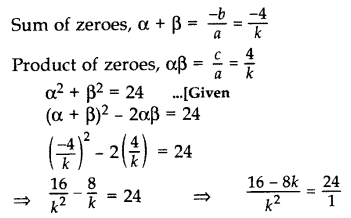
⇒ 24k2 = 16 – 8k
⇒ 24k2 + 8k – 16 = 0
⇒ 3k2 + k – 2 = 0 …[Dividing both sides by 8]
⇒ 3k2 + 3k – 2k – 2 = 0
⇒ 3k(k + 1) – 2(k + 1) = 0
⇒ (k + 1)(3k – 2) = 0
⇒ k + 1 = 0 or 3k – 2 = 0
⇒ k = -1 or k =
Question 34.
If α and β are the zeroes of the polynomial p(x) = 2x2 + 5x + k, satisfying the relation, α2 + β2 + αβ =
Solution:
Given polynomial is p(x) = 2x2 + 5x + k
Here a = 2, b = 5, c = k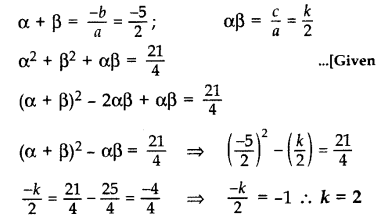
Question 35.
What must be subtracted from p(x) = 8x4 + 14x3 – 2x2 + 8x – 12 so that 4x2 + 3x – 2 is factor of p(x)? This question was given to group of students for working together. (2015)
Solution: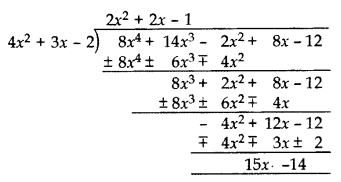
Polynomial to be subtracted by (15x – 14).
Question 36.
Find the values of a and b so that x4 + x3 + 8x2 +ax – b is divisible by x2 + 1. (2015)
Solution: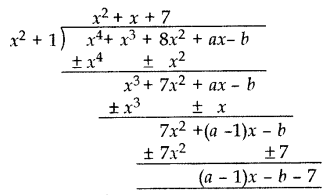
If x4 + x3 + 8x2 + ax – b is divisible by x2 + 1
Remainder = 0
(a – 1)x – b – 7 = 0
(a – 1)x + (-b – 7) = 0 . x + 0
a – 1 = 0, -b – 7 = 0
a = 1, b = -7
a = 1, b = -7
Question 37.
If a polynomial 3x4 – 4x3 – 16x2 + 15x + 14 is divided by another polynomial x2 – 4, the remainder comes out to be px + q. Find the value of p and q. (2014)
Solution: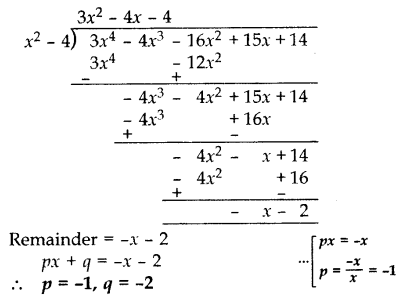
Question 38.
If the polynomial (x4 + 2x3 + 8x2 + 12x + 18) is divided by another polynomial (x2 + 5), the remainder comes out to be (px + q), find the values of p and q.
Solution: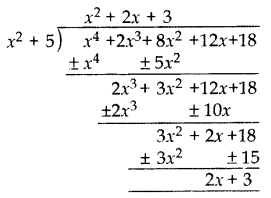
Remainder = 2x + 3
px + q = 2x + 3
p = 2 and q = 3.
Class 10 Maths Notes Chapter 2 Polynomials
- “Polynomial” comes from the word ‘Poly’ (Meaning Many) and ‘nomial’ (in this case meaning Term)-so it means many terms.
- A polynomial is made up of terms that are only added, subtracted or multiplied.
- A quadratic polynomial in x with real coefficients is of the form ax² + bx + c, where a, b, c are real numbers with a ≠ 0.
- Degree – The highest exponent of the variable in the polynomial is called the degree of polynomial. Example: 3x3 + 4, here degree = 3.
- Polynomials of degrees 1, 2 and 3 are called linear, quadratic and cubic polynomial respectively.
- A polynomial can have terms which have Constants like 3, -20, etc., Variables like x and y and Exponents like 2 in y².
- These can be combined using addition, subtraction and multiplication but NOT DIVISION.
- The zeroes of a polynomial p(x) are precisely the x-coordinates of the points, where the graph of y = p(x) intersects the x-axis.
If α and β are the zeroes of the quadratic polynomial ax² + bx + c, then
If α, β, γ are the zeroes of the cubic polynomial ax3 + bx2 + cx + d = 0, then
Zeroes (α, β, γ) follow the rules of algebraic identities, i.e.,
(α + β)² = α² + β² + 2αβ
∴(α² + β²) = (α + β)² – 2αβ
DIVISION ALGORITHM:
If p(x) and g(x) are any two polynomials with g(x) ≠ 0, then
p(x) = g(x) × q(x) + r(x)
Dividend = Divisor x Quotient + Remainder
Remember this!
- If r (x) = 0, then g (x) is a factor of p (x).
- If r (x) ≠ 0, then we can subtract r (x) from p (x) and then the new polynomial formed is a factor of g(x) and q(x).
- Chapter 1 Real Numbers
- Chapter 2 Polynomials
- Chapter 3 Pair of Linear Equations in Two Variables
- Chapter 4 Quadratic Equations
- Chapter 5 Arithmetic Progressions
- Chapter 6 Triangles
- Chapter 7 Coordinate Geometry
- Chapter 8 Introduction to Trigonometry
- Chapter 9 Applications of Trigonometry
- Chapter 10 Circle
- Chapter 11 Constructions
- Chapter 12 Areas related to Circles
- Chapter 13 Surface Areas and Volumes
- Chapter 14 Statistics
- Chapter 15 Probability
.png)
.png)